You are using an outdated browser. Please upgrade your browser to improve your experience.


Masts and Booms
- Spinnaker Poles
- Whisker Poles
- Mast Section Diagrams
- Capabilities
- Applications
- Manufacturing Processes
- Order Online
Improve sailing performance
With forte’s super durable carbon masts and booms.
Forte masts and booms are manufactured using 4-Axis Continuous Fiber Braided Technology originally developed for military applications requiring “super durability” – the ability to withstand bullet shots and to resist spread of damage.

Why Buy A Forte Carbon Fiber Mast?
Forte also uses proprietary process control computers to strategically place and braid each carbon fiber strand directly onto a precisely engineered mandrel. The finished mast is then consolidated and cured at high temperature.
Save Weight Aloft
A Forte carbon fiber mast weighs about half that of an aluminum mast. Weight savings aloft translates into increased righting moment and reduced pitching moment. In heavier winds, your boat will pitch less in chop. Increased righting moment means you can keep more sail up and/or sail with less crew under any heavier conditions.
Yes a carbon mast can be affordable! Our automated manufacturing process allows us to manufacture carbon spars with less hands-on labor than other manufacturers. This means lower cost for you. Also, with some aluminum extrusions becoming scarce along with the labor to have the extrusion tapered…You may be surprised how affordable a Forte carbon spar can be.
Double Life Expectancy
Carbon fiber masts require less maintenance than aluminum masts; carbon fiber does not corrode, and paint flaking associated with aluminum masts does not occur. And, because softer (i.e., lower modulus) aluminum masts are subject to greater fatigue than carbon fiber masts, a Forte carbon fiber mast has at least double the life expectancy.
Transfer Power Efficiently
Power created by your sails is transferred by your mast to your hull. Softer aluminum masts lose some of this power because of bending, flexing and vibration. Due to greater strength and stiffness, a carbon fiber mast efficiently transfers the power from the wind into forward sailing momentum for greater speed.
Meeting Every Requirement
Forte carbon fiber masts are engineered to meet your exact requirements. Your mast can be built straight or tapered, to your specified weight or stiffness. Localized reinforcements (additional material) are laminated into the spar at areas of high stress and locations of any hardware or holes in the spar wall.
Spars can be ordered as a blank (bare carbon tubing) or a fully finished and painted mast.
We build OEM masts for manufactures such as:
- Classic Boat Shop
- Zim Sailing
Whether Cruising or Racing
You can expect your forte carbon mast to improve your boat’s sailing performance..
Order Online Contact Us Today!
what they’re saying
The carbon fiber tubing we use in the Mosquito Air Helicopter has proven to be very reliable and strong. Forte offers a good product at a very reasonable price.
Before and during the 2002/2003 Around Alone race, we broke every type and every brand of sail batten you can imagine. This is one thing about Ocean Planet’s unstayed (freestanding) mast, that it is very tough on battens. However, for the end of the Around Alone and for the Vendee, we are using custom braided S-glass/carbon fiber battens by Forte… Forte battens are incredible, and it is so nice not to have to worry about battens anymore.
Thanks for the awesome new mast for Strummer. It’s made a huge difference; she’s a much better boat, definitely stiffer and faster. We took 2nd (Class IV) in this year’s (2007) Bermuda 1-2. Lots of days in the 25-30 knot range. No problems with the rig at all.
My Forte mast is fantastic. It is light and extremely strong… two gales in the Bay of Biscay and three flying gybes (thanks to autopilot malfunctions) with the spinnaker up, and each time it came through unscathed. ACADIA Once I gybed in 30 knots of wind 2 miles from the finish with a full main and broke one of the running backstays, so no backstays on downwind… no problems.
Strong, light and fairly priced ~ a good value! That’s what our clients tell us about their Forte poles. And we appreciate having a reliable source of spinnaker poles to meet our clients’ expectations.
I would like to thank you, Tony and all the crew at Forte for the great service and excellent product. As you know, we were without a supplier for a mast, spirit and spinnaker pole for the new Rocket, and your company was the only one with a “can do!!”attitude. Right from helping us to pick the correct mandrel, creating the laminate schedule, to helping us construct the first mast, you went beyond the call of duty. We were nervous that the mast would be too stiff, and had lots of “nay sayers”, but when we set the rig up and went for our first sail, it was just what we were looking for!! Keep up the great work!!

- © 2024 Forte Carbon Fiber | Carbon Fiber Tubing Manufacture. All Rights Reserved.
- 860.464.5221
- [email protected]
- Store Policies & Privacy
- 14 Lorenz Industrial Pkwy. Ledyard, CT 06339
- TECHNICAL SUPPORT
LEADERS IN EVERY DETAIL
Every Seldén rig is carefully thought out, down to the last detail. All the way from the materials and functions of the different parts of the rig, to dimensioning the right rig for each individual boat. Each component contributes to the performance of the whole rig. That is the Seldén way – experienced yachtsmen behind every aspect of design, product development and production.
CONVENTIONAL MASTS FOR YACHTS
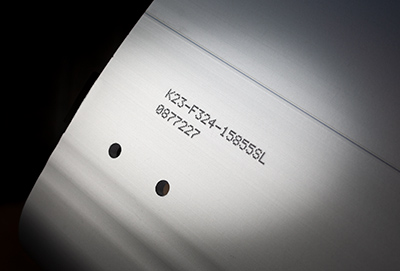
Spareparts and aftermarket service
Since 1992 we have engraved a unique code into the mast section. We call it the mast ID number and you find it at the lower end of the aluminium section. This number tells us when your mast was built and what parts were used all the way down to nuts and bolts. The mast ID number includes the designation of your mast section which enables you to find part numbers in our catalogues and sparepart lists, all to be found under Technical Support. A corresponding number is to be found in the forward lower end of your boom. Best of all – take a close look at the components on your mast and you will find part numbers on them. Can it be simpler? Complete rigs and spareparts are sold by our World wide network of independent rigging companies.

Our conventional masts for 26-80 feet yachts are divided in two categories. The longitudinal oriented sections and the lateral oriented. Which one we select depends on the chain plate locations of the boat and number of spreaders.
LONGITUDINAL MAST SECTION
These sections are used for rig configurations with in-line spreaders or moderate spreader angles. The relationship between the length / width is 1,9 in order to create longitudinal stiffness allowing higher forestay load tensioning the backstay. Running backstays can often be avoided and the risk of mast pumping is also reduced. These rigs normally come with multiple pairs of spreaders and they are designed for the popular MDS sliders (Multi Directional Support).
LATERAL MAST SECTION
For rigs with large spreader angles, lateral stiffness is of higher importance than longitudinal stiffness. This is the result of a large spreader angle creating longitudinal stability, whereas the lateral stability is achieved by the geometry of the mast section. This makes for a mast section which is wider and rounder than the corresponding longitudinal section and therefore the number of spreaders can be reduced. These sections are popular for upgrading a boat from the 1970-90’s with a traditional style single spreader rig, but still with all the benefits of modern functions such as the Inner Wheel Sliders (IWS).

WHAT IS A KEELBOAT?
Seldén’s definition of a ”keelboat” is a boat sized in between a dinghy and a yacht, with a length of approximately 18-28’. These boats often have a 50% ballast ratio. Consequently, the weight of the keel represents half of the total displacement.
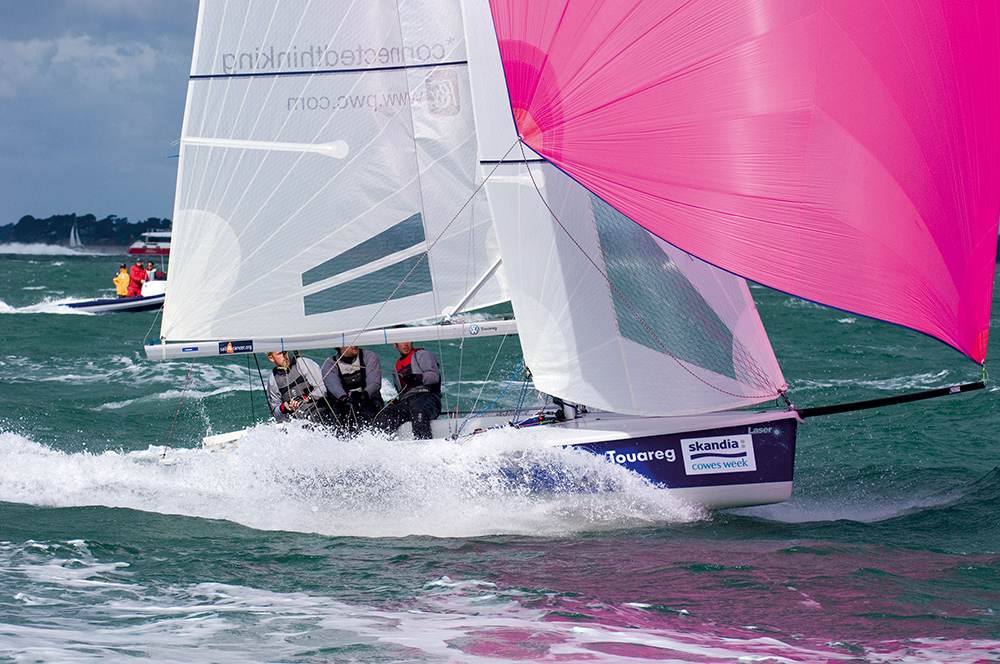
Tradition and development
Seldén’s seven aluminium keelboat sections feature a wealth of sophisticated and functional solutions, originating from the dinghy range and the yacht range. The sections are extruded and anodized and they are all available with a tapered top as an option. Let us design your keelboat rig or ask us for our One-design solutions.
- Keelboat masts
FURLING MASTS
A seldén furling mast lets you operate your mainsal from the cockpit. simple and convenient.
Its unique features for reducing friction and initial sail resistance make furling and reefing child’s play. And it also makes sailing safer and far easier for you and your crew. With a powered furling mast and a powered Furlex jib furler it is even easier to set, reef and handle your sails. You can work your sails single handed, without leaving the helm. Powered systems are available for yachts ranging from 35 to 70 feet.
MORE ENJOYABLE
Due to the easy handling, with a furling mast you will do more sailing and less motoring.
A Seldén furling mast makes it easy to unroll and set your mainsail. Rolling it in is just as quick and easy. As your sail is neatly stowed out of the way the instant it is rolled in, you have a clear view when manoeuvring under power.
You can set your sail to suit the weather conditions, from the safety of the cockpit.
By furling the sail vertically into the mast, you don’t have to furl very much to get a substantial decrease of the sail area.
You hoist the sail just once a season, so a small crew can manage a much larger boat.
WELL BALANCED
There are no fixed reef points, so the number of combinations between furling genoa and main are unlimited.
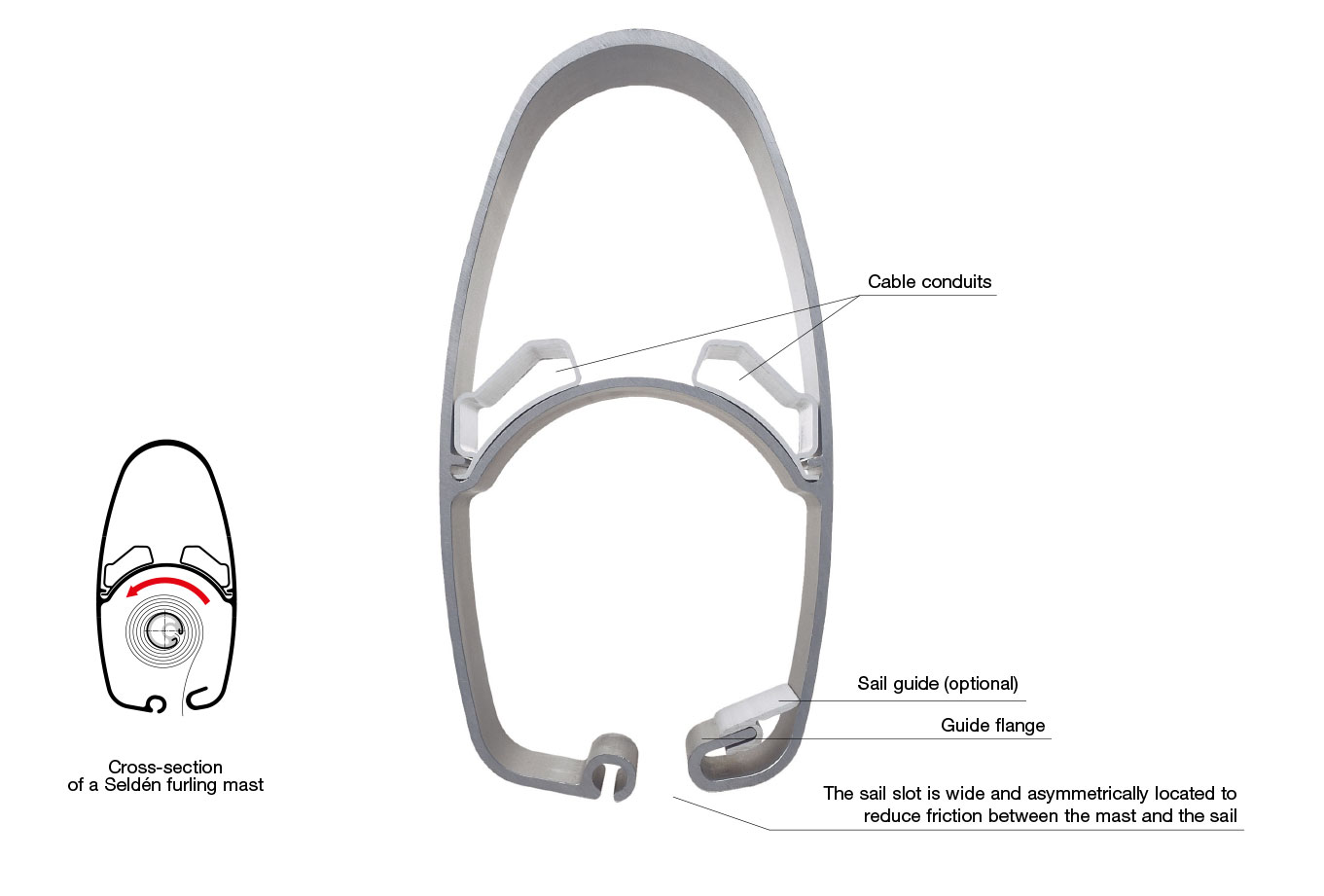
THE SELDÉN FURLING PRINCIPLE
The wide sail slot allows for vertical battens and a positive roach of the main sail and the sailgroove on the luff extrusion is located asymmetrically to help the sail furl easily around the extrusion.
The furling system is based on Seldén’s proven technology. Geared line driver winch, tensioned luff extrusion and the patented load distributor of the halyard swivel. All to make furling an easy and fast operation. The Seldén furling masts come with twin cable conduits, enabling the cables to run freely and well protected from all running rigging. The cable conduits also facilitate cable replacement.
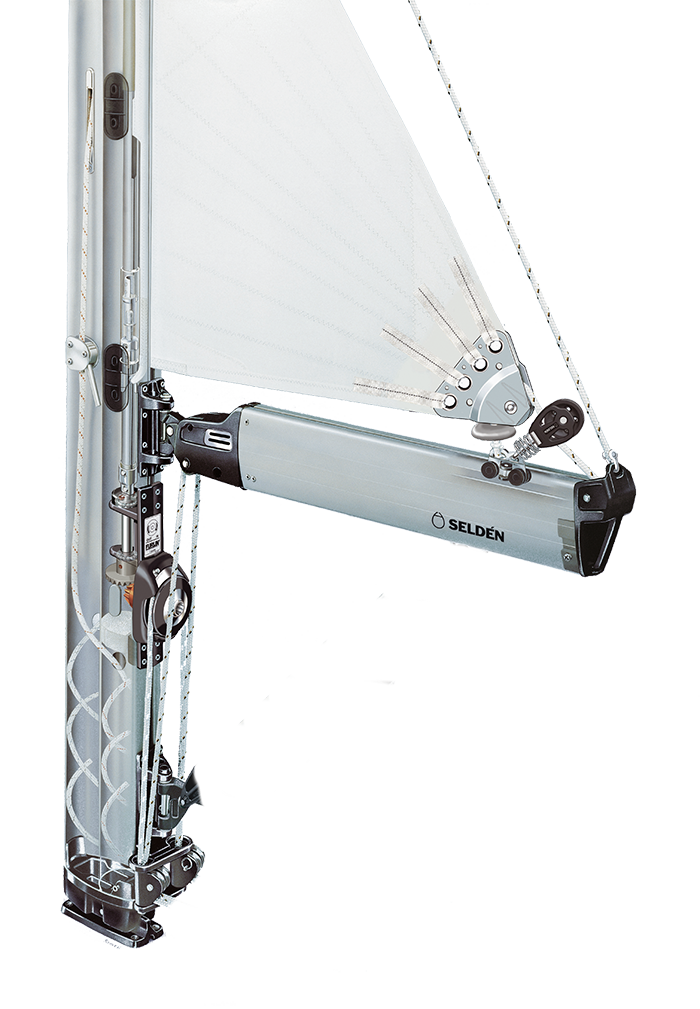
EASY TO OPERATE
There is an outhaul line for rolling out the sail, and an endless line for rolling it in. It’s simple as it sounds. Or if you wish, you can operate the sail at the mast using a winch handle. The geared reefing winch mechanism runs on ball bearings, so it takes little effort to roll in the sail. Greasing holes in the mast facilitate maintenance.
Two oval holes on the port side of the mast allow for easy access to the tack attachment, sail fees, tensioning screw and halyard swivel. Just remove the composite covers and the rest speaks for itself. You can inspect the halyard swivel and carry out annual maintenance through the upper access hole.
ABSORBS ALL SAIL FORCES
The outhaul cars are fitted with horizontal and vertical wheels, enabling them to absorb forces from every direction.
TURNING BLOCK FOR CONTROL LINES
Turning blocks at the base of the mast are designed to enable the ready-spliced, endless line to be easily threaded into position. Seldén deck blocks have the same feature.
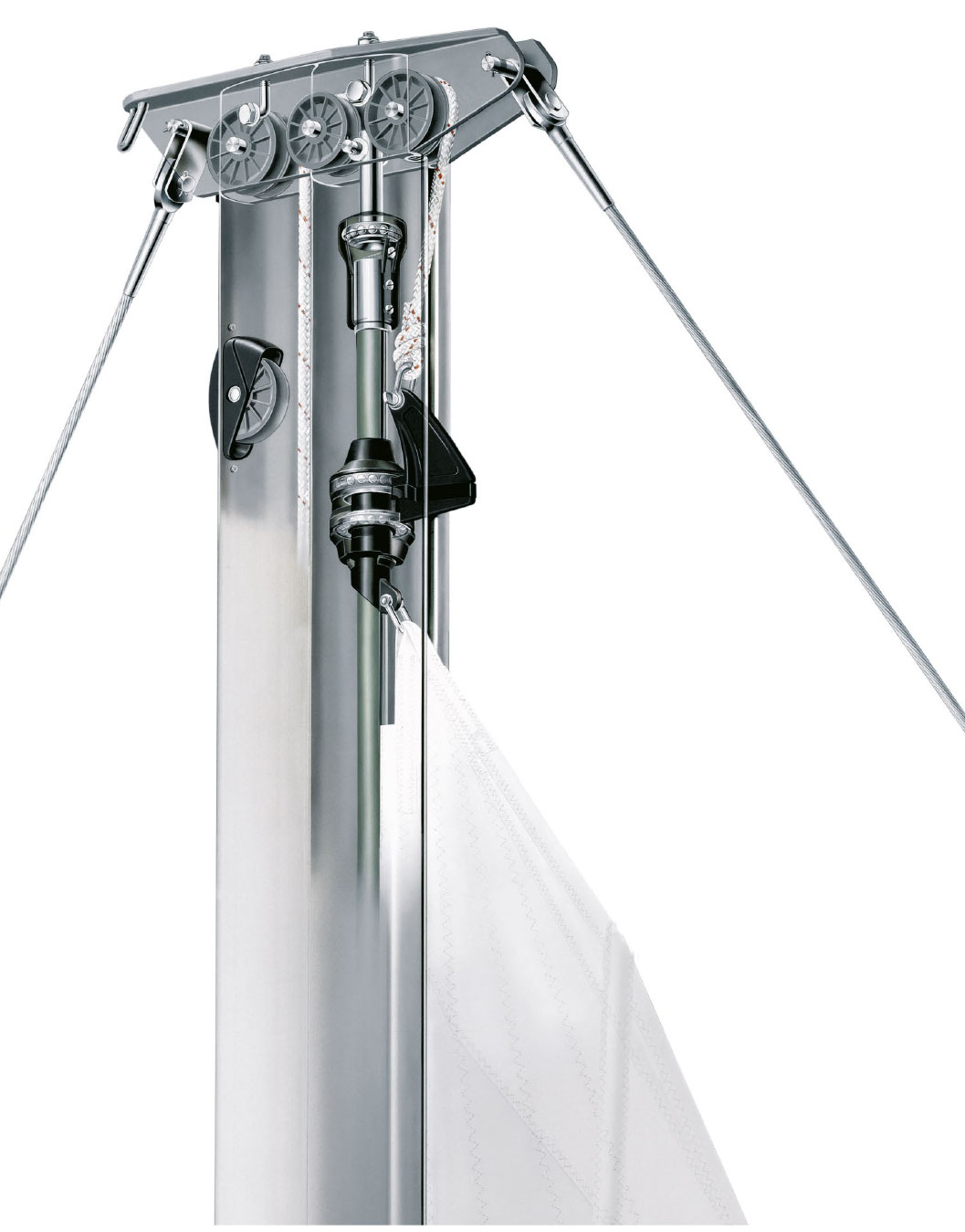
LOW FRICTION
The sail groove on the luff extrusion is located asymmetrically to help the sail furl easily around the extrusion. In addition, the rotating luff extrusion is tensioned and fitted with ball bearings top and bottom. This reduces friction between the sail and the inside of the sail compartment.

UPGRADE YOUR MAST TO ELECTRIC DRIVE
To make sail handling easier for a small crew we have synchronized an electric motor in the mast with a newly developed electric winch for the outhaul, E40i. Push a button and the sail comes out in a controlled fashion as the winch adjusts the outhaul tension in relation to the motor in the mast. This is what we call Synchronized Main Furling.
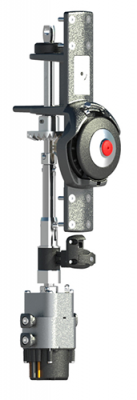
IN-MAST FURLING MOTOR
Converting a manually operated furling mast is quite easy. Basically, the vertical shaft in the original line driver is replaced for a longer version which is connected to the motor. A clutch allows the motor to be disconnected for manual operation, if ever needed. The motor is completely integrated in the mast and connected to the Seldén Power Supply and SEL-Bus system. The motor can be retrofitted to Seldén furling masts type RB (~36-43’ yachts).
How to upgrade a furling mast to electric drive
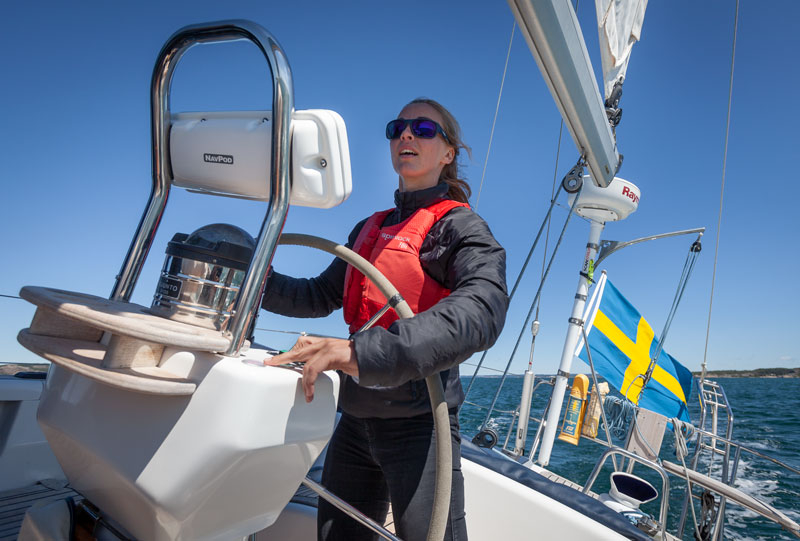
PUSH BUTTONS
Push the ”OUT” button and the sail will start to unfurl. The E40i winch will tension up the outhaul while the mast motor feeds out the sail. The speed is increased when the ”IN” button is pushed in addition to ”OUT”. To reef, just release the outhaul from the winch and push ”IN”.
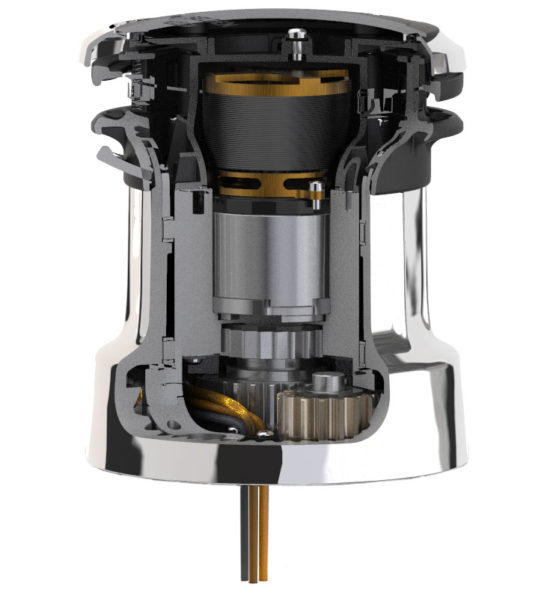
E40i ELECTRIC WINCH
The E40i winch is built up around an electric motor which is totally integrated in the drum. Only three thin cables are protruding to lead through the coach roof or the deck, no large cutouts and no external motor or gearbox. This makes for uncompromised headroom down below which is normally not the case with electric winches. The three speed operation provides a high speed gear, a moderate gear and a low speed gear for fine tuning. It is a two finger operation to start the winch and to swich gear, so a single-handed sailor can helm while adjusting the trim.
HOW IT’S CONNECTED
- Upgrade your mast to electric drive
Seldén Carbon fibre masts – the perfect mix of Craftsmanship and modern production Technology
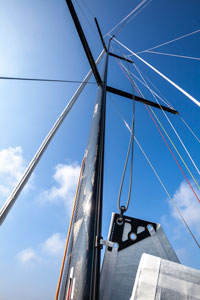
FOR EVERYONE THAT CANNOT RESIST SPEED
Carbon composite combines stiffness and strength with low weight. Seldén low-weight carbon spars have accentuated longitudinal stiffness. This means that forestay tension can be substantially increased. All experienced racing sailors know what this means in terms of increased upwind performance. The combination of greater stiffness and reduced weight will bring you beyond the speed limits.
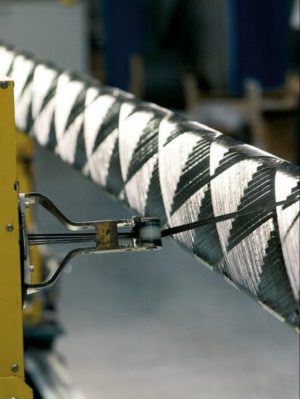
MANDREL FILAMENT MOULDING
Our carbon spars are designed using the latest finite element analysis backed by many years of solid engineering experience.
Our unique production method gives a unique look. We call it Mandrel Filament Moulding (MFM). The process is fully automated and computer controlled for ultimate accuracy, repeatability, efficiency and that stunning ‘Viper’ pattern.
Seldén produce over 400 carbon masts per year as well as booms, poles and bow sprits for boats including high performance skiffs, racing keelboats, IRC race boats and some of the world’s most prestigious cruising yachts. With more sailors choosing Seldén carbon spars, the pattern is obvious.

- Carbon spars
- Carbon masts
SELDÉN DINGHY RIGS – GOING FOR GOLD
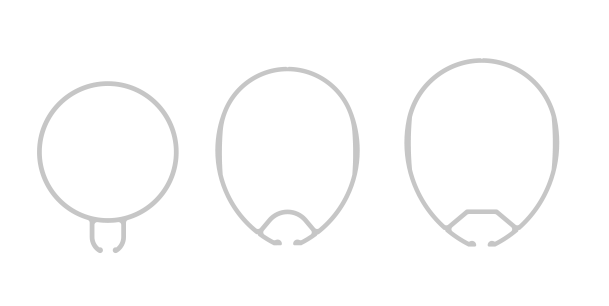
SELDÉN PROFILES
Working hand-in-hand with the world’s top dinghy sailors, carefully analysing their input and feedback, enables us to produce the ultimate Seldén dinghy rig for every boat. Ever since Seldén acquired Proctor in 1997, we have improved and developed the already acknowledged excellence of the Proctor products, so that they are now, like all other Seldén products, the best of the best. Our innovative design, attention to detail, advanced testing and manufacturing have won Seldén the trust of dinghy sailors all over the world and has contributed to numerous Championship medals.
- Dinghy masts
- Class reference guide
SELDÉN DINGHY CARBON RIGS
– the Mast you buy will perform as well for you as it will for a World Champion Sailor!
IN-HOUSE SPECIALIST DESIGN TEAM
Seldén has the design expertise and software to enable us to create a mast to meet exacting performance requirements. During the design process the position and alignment of each fibre is precisely calculated so as to meet the required bend characteristics. This detailed design is then used to program and control our filament winding equipment.
The combination of meticulous care, long experience, and exact specifications enable us to achieve optimum performance for minimum weight.
Computer controlled laminate lay-up Carbon filaments are wound around a mandrel (male mould), under controlled tension, via a designated winding program supplied by the design team.
FILAMENT WINDING, a computer-controlled process (CNC), guarantees consistent and accurate filament fibre orientation from spar to spar. Carbon filaments can be laid from 0° (uni-directional) to leave 89° (hoops) and at all angles between to produce a wide range of bend characteristic requirements. This accurate alignment of composite filaments is vital to the performance characteristics of a carbon spar. Fibres are laid under tension, which means that we can make the most efficient material choice and supply the lightest spars on the market.
This process gives a Seldén spar a level of tube consistency unattainable via any other composite manufacturing technique. Hence, the mast you buy will perform as well for you as it will for a world champion sailor!
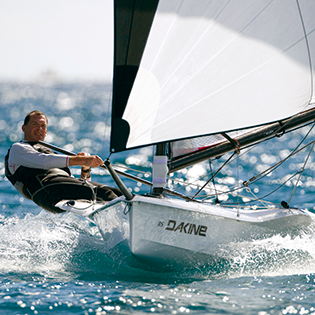
USE OF PRE-PREG CARBON
Only the highest grade pre-preg tows of T700 or TZ carbon fibre are used to give sailors the best stiffness-to-weight spar. This, in combination with our filament winding process, enables the highest fibre-to-resin content pre-preg to be used.
The aerospace grade pre-preg has a UV stabiliser in the resin system to give the spars a guaranteed long life, even in the sunniest of climates. More fibres and less resin, mean lighter, stiffer masts.
AUTOCLAVE CURED
The consolidation of the material to form a ready-to-assemble carbon tube is completed in our in-house 20-metre long autoclave. The combination of heat and pressure to cure the resin and consolidate the pre-preg material ensures a strong and consistent final product.
- General conditions of sale >
- Product recalls >

Cookies | Legal and Privacy | Copyright © 2024
This site uses cookies
Read more about cookies .

FINEST CARBON MASTS
A mast is one of the most dynamic and complex components of a yacht, with the job of transferring the power generated by the wind and sails into the yacht. It must withstand a multitude of ever-changing forces, including torsion, bend and compression. Yet it must maintain the perfect combination of stiffness and flexibility to maximize performance of the sail plan.
At Southern Spars we are spurred on by two key drivers; performance and reliability. The foundations of our success in these areas are sound principles of design and manufacture, combined with a detailed understanding of our customers’ requirements.
At Southern Spars, we build packages for everything from mega yachts, to race yachts and Olympic dinghies. Developments made in one area are disseminated through all of our teams, meaning the rate of progression throughout the company is extremely high.
WE BUILD MASTS FOR…
Grand prix / racing, classic cruiser.
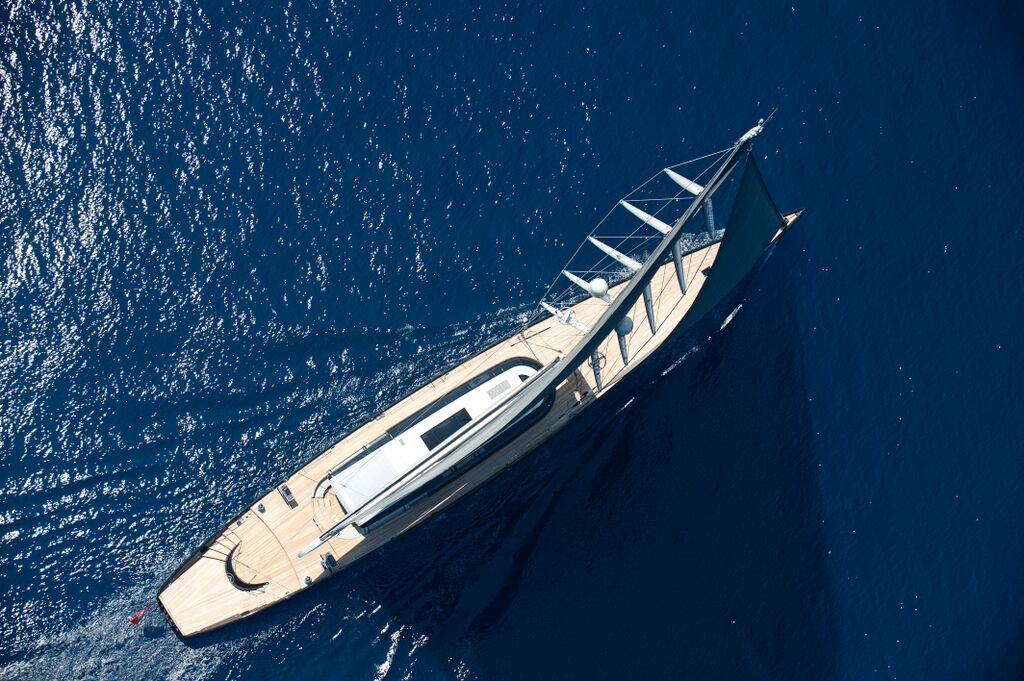
Phenomenal strength is needed in the mast and rigging to support a superyacht’s immense sail plan. The yacht’s dimensions must be balanced with the mast and boom for both aesthetics and engineering capabilities. Modern superyacht spars have added functionality like furling mainsails, and rafts of electronic, navigation and communications components.
As superyacht owners seek ever-larger and more performance-oriented yachts, designs draw extensively on developments made in the Grand Prix arena. Southern Spars’ ECsix continuous carbon fibre rigging is now used in most superyacht projects. Thin ply carbon fibre for mast construction is also beginning to cross over the race/luxury boundary.
The many international design awards won by superyachts carrying Southern Spars’ packages highlights the vital role that our team plays in creating world-leading superyachts.
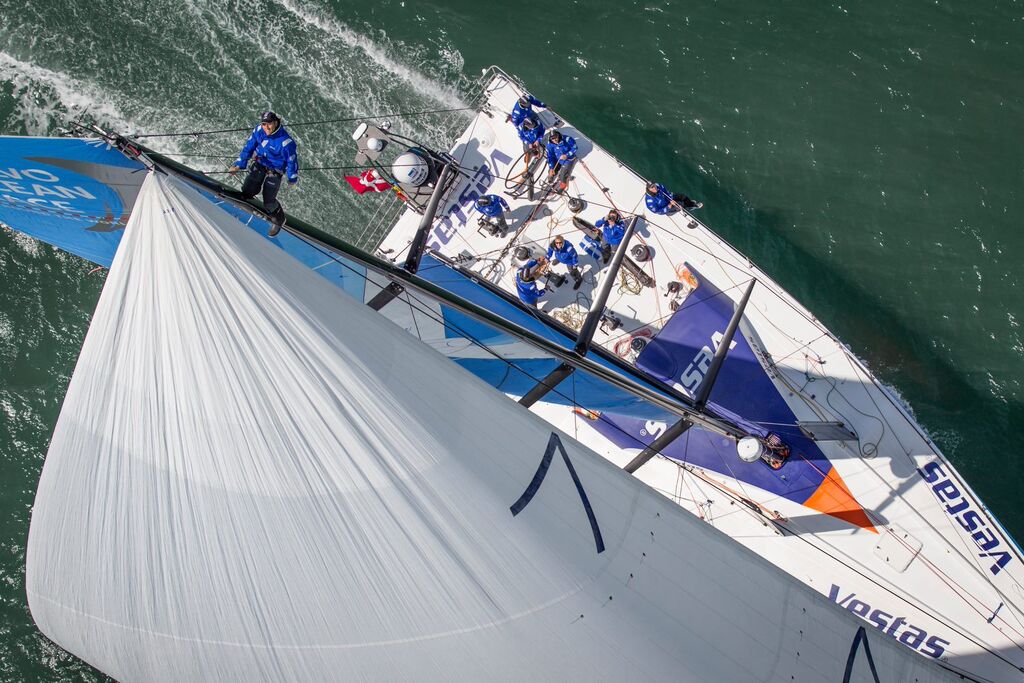
With almost universal domination of the world’s elite inshore, offshore and around the world events; Southern Spars’ race results speak for themselves.
Our dedication to performance and reliability makes us the obvious choice for racing yachts that want the edge over their competitors with a product that they can trust. Throughout the design process , we integrate the sail maker’s design into our own so that the spars and sails work as one cohesive unit. This enables racers to extract maximum performance and trust that the mast will get them across the finish line.
Southern Spars rigs are made from thin ply carbon fibre , which allows us to design tubes lighter and stronger than our competition, while achieving a more accurate bend profile.
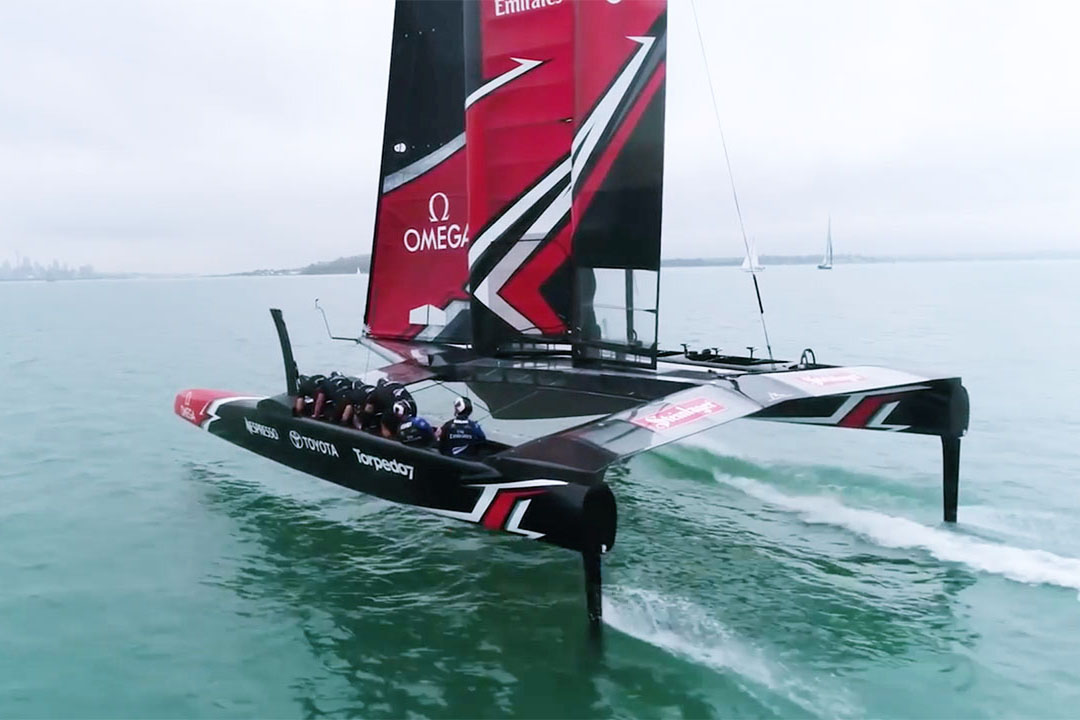
The spirit of multihull yachts is generally more radical, not conforming to the limits imposed on monohulls. Catamarans and trimarans often seek something different and more exciting – a spirit embraced by Southern Spars.
Multihulls allow many different rig and rigging configurations, which allows Southern Spars to design innovative and often unique solutions to aid the yacht’s performance.
We work together with the yacht’s designer and sailmaker to ensure the whole yacht works together to embody the essence of multihull sailing – the perfect combination of comfort, space and effortless speed.
Southern Spars’ carbon technology allows us to build more than just masts. We produce many of the carbon components in a multihull including the crossbeams, spine, and bowsprit for everything from foiling AC72s to multihull superyachts.
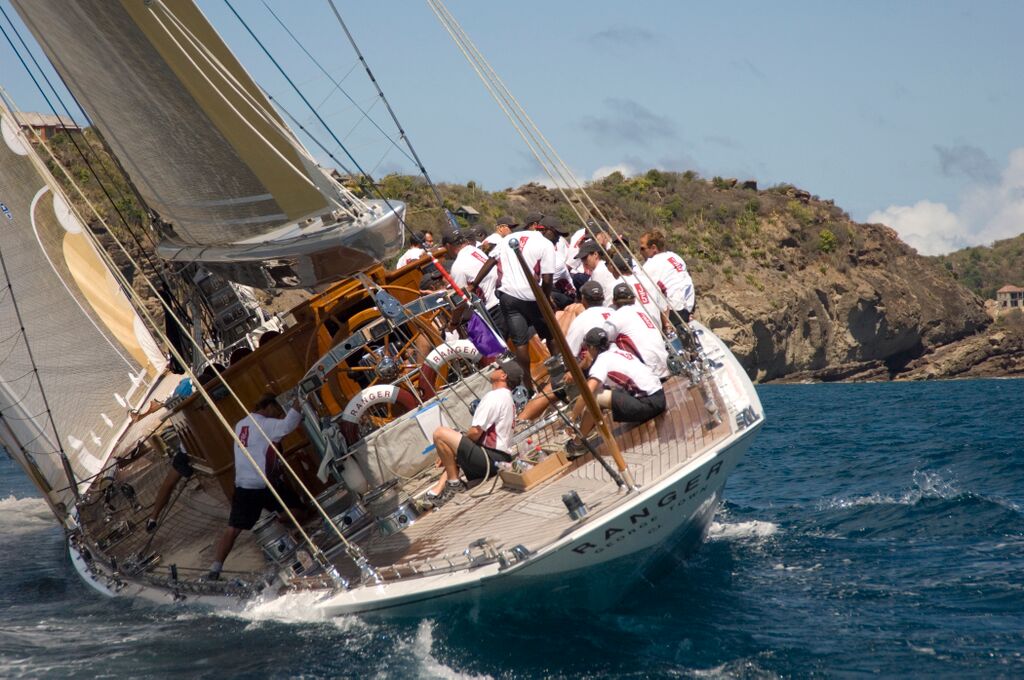
One of the best ways to bring new life to an older vessel is to upgrade the spar package. Doing so will significantly increase its performance, safety and ease of operation making sailing more enjoyable and therefore done more often.
Classic yachts are great to look at, but can be difficult to sail. Upgrading to a carbon mast from Southern Spars will make an older yacht sail like new one, with a more efficient sail plan and improved righting moment. Southern Spars’ attention to detail, from design through manufacture to paint and final fit out mean that all of this can be done without compromising any of the cosmetic attributes or traditional feel of your yacht.
Southern Spars have built new carbon fibre masts for single, double and triple masted classic yachts, cutting significant amounts of weight and improving the reliability of a rig package.
Carbon Fiber Sailing Boat Mast
Product description.
Introducing our Carbon Fiber Sailing Boat Mast, a superior product designed to enhance your sailing experience. This mast is constructed with high-quality carbon fiber, ensuring durability and strength while maintaining a lightweight design.
| Parameter | Value |
|---|---|
| Material | Carbon Fiber |
| Length | Varies (customizable) |
| Diameter | Varies (customizable) |
| Weight | Lightweight (approx. 30-50% less than aluminum) |
| Strength | High strength-to-weight ratio |
| Durability | Resistant to corrosion and fatigue |
| Installation | Easy and quick installation |
| Customization | Available in various sizes and specifications |
| Performance | Improved sailing experience due to reduced weight and increased strength |
Application
Racing Sailboats: The lightweight and strong nature of carbon fiber makes it ideal for use in racing sailboats. It helps to reduce the overall weight of the boat, allowing for faster speeds and improved maneuverability.
Cruising Sailboats: Carbon fiber masts are also commonly used in cruising sailboats. They provide the necessary strength and durability required for long-distance sailing while still maintaining a lightweight design.
Catamarans: Due to their wider beam and increased stability, catamaran sailboats often require larger and stronger masts. Carbon fiber is an excellent material for this application as it can withstand the additional stresses and strains.
High-Performance Yachts: For luxury yachts that prioritize speed and performance, carbon fiber masts offer significant advantages. They help to reduce weight and increase stiffness, resulting in improved handling and faster speeds.
Inflatable Boats: Carbon fiber masts can also be used in inflatable boats, providing the necessary support and stability without adding excessive weight. This is particularly important in recreational boats where ease of transport and storage are important factors.

Lightweight:
Carbon fiber is much lighter than aluminum or steel, which means that carbon fiber masts can significantly reduce the overall weight of a sailing boat. This reduction in weight can lead to improved performance, including faster speeds and better maneuverability.
High strength-to-weight ratio:
Carbon fiber has a high strength-to-weight ratio, meaning that it can be incredibly strong while still being lightweight. This makes carbon fiber masts ideal for sailboats that need to withstand heavy loads and stresses, such as racing boats or high-performance yachts.
Corrosion resistance:
Unlike aluminum or steel masts, carbon fiber masts are resistant to corrosion. This means that they require less maintenance and have a longer lifespan than traditional masts.

Aesthetics:
Carbon fiber masts have a sleek, modern appearance that many sailors find attractive. They can also be customized with different colors and finishes to match the rest of your boat’s decor.
Cost-Effective:
While carbon fiber masts may be more expensive than aluminum or steel masts initially, they can actually be more cost-effective in the long run. This is because they require less maintenance and have a longer lifespan, meaning you won’t need to replace them as often.
Our Advantages

Complete set of tooling
We have been producing roll-wrapped carbon fiber tubes for over 20 years, and over the years, we have accumulated a wide range of tooling that covers almost all sizes from 2mm to 200mm, high production capacity.
We have a total of ten roll-wrapping machines, with a maximum capability of producing tubes up to 3 meters in length. Our production capacity ensures a daily output of 2000 meters of roll-wrapped tubes.

High product precision
We have multiple automated high precision centerless grinders that ensure dimensional accuracy of each tube within a tolerance of ±0.05.
Catering to various customized processing needs

Certificate

Testing Equipment
Our company is equipped with various testing equipment to perform strength and performance tests on fiberglass and carbon fiber products of various sizes. This ensures consistent product quality and enhances overall reliability.

Are you a retail seller? No, we are a factory and only accept bulk orders. Our minimum order quantity (MOQ) is 1000 pieces.
What payment methods do you accept? We accept payment via T/T (Telegraphic Transfer) and LC (Letter of Credit).
Can all products be customized? Yes, we offer customization options for all our products. You can specify your requirements, such as dimensions, colors, and other specifications, and we will tailor the products accordingly.
Can I get samples before placing a bulk order? Certainly! We provide samples, and you can request up to 10 pieces for evaluation purposes. Please note that samples may incur a nominal fee.
What are the available shipping methods? We offer various shipping options to accommodate your needs. You can choose between sea freight, express delivery, rail transportation, or air freight.
What is your monthly production capacity? Our average monthly production capacity is 1 million meters. However, this may vary depending on the specific product and customization requirements.
Do I need to pay a deposit before production starts? Yes, a deposit is required before we commence production. Once we receive the deposit, we will initiate the manufacturing process.
Please feel free to reach out to our sales team for any further inquiries or specific requirements. We are here to assist you and provide the best solutions for your bulk order needs.
we provide the following services:
- OEM /ODM service and support
- Free promotion material if needed
- Clients service one-to-one
- Effective communication within 24 hours
- New design and style collection updating for customer
Send Us A Message
- Applications
- Carbon Fiber Products
- Fiberglass Products
- Sort By Process
- Uncategorized
Table of Contents
You may also like.

Mask For Welding

Motorcycle Fender

Powered Electric Surfboard
Powered Electric Surfboard Product Description Carbon Fiber Powered Electric Surfboard is a cutting-edge watercraft designed to provide an exhilarating and environmentally friendly riding experience. Crafted
- Shenzhen Headquarter Add: Yongfu building, baoan, shenzhen, Guangdong,P.R.China
- Dongguan Factory Add: Xiaqiao Industrial Park, Dongcheng, Dongguan, Guangdong , P.R.China
- Huizhou Factory Add: Shiwan Technology Park, Shiwan, Boluo, Huizhou, Guangdong,P.R.China
- 0086 0769-81912340
- 0086 159 1431 5366
- [email protected]
Product Categories

Leave Us a Message

- Subscriptions
Grab a Seat at the Captain’s Table
Essential news coupled with the finest maritime content sourced from across the globe.

Join our crew and become one of the 108,426 members that receive our newsletter.

Future Fibres’ Giant Carbon Mast Will Carry Largest Sail Ever Made
Share this article.
Built of carbon fiber by Future Fibres, this 75.8m, 16.4 ton mast is among the top three tallest masts in the world and will soon fly the world’s largest sail, a 2,602 square meter A2 asymmetrical spinnaker.
Future Fibres notes that 4,752 kilometers of carbon fiber was used to make the rigging which also includes a 23.4m carbon fiber pre-preg furling boom, carbon fiber cap stays and diagonals, as well as fore and aft stays made of a combination of Carbon, PBO and Kevlar.
Doyle sailmakers spent 6,000 hours designing the 10,000 square meter sail inventory, an area which is 1000 square meters larger than the playing field at NRG Stadium, or half the size of the MCG in Melbourne. Doyle notes the A2 is comprised of 3,200 yards of Dyneema and Polyester fabric.
The dimensions of the asymmetricals and the Code 0 are such that the fabric available on the market was not capable of providing the necessary characteristics of strength and lightness, therefore special new fabrics were created after extensive R&D activities. Robbie Doyle notes this sail package “is one of the most unique and challenging ever created.”
All images courtesy of Perini Navi:

Future Fibres commented on the weight optimization of the huge carbon mast saying, “we have managed to produce a tube with a perfect exterior surface and a flawless Clearcote gloss Carbon finish with zero filler – which can add up to 3 per cent to the weight of a mast.”
Handling the jibs are a pair of primary winches that can pull a maximum of 30 tons and have a maximum lines speed of 40 meters per second.
The rig was installed at the Perini Navi facility in La Spezia, Italy
Technical Features
- Mast: 75.8m Carbon Fibre by Future Fibres
- Boom: 23.4m Carbon Fibre by Future Fibres
- Standing rig: Lateral Rigging in Carbon Fibre
- Aft and Fore Stays in Carbon+PBO+Kevlar
Sail Inventory:
- Main Sail 808 m 2 – includes 1,140,000 meters of Carbon and Technora fibers
- The mast features 4 main sail locks: 1 full hoist + 3 reefs
- Batten car system
- Cunningham ram
- Reacher 1,160 m 2
- Blade 706 m2 with carbon vertical battens
- Staysail 370 m 2 – On soft hanks and removable torque cable
- Code 0 1,804 m2 – on the biggest torque cable TDF ever built by Future Fibres
- A2 2,602 m 2
- A3 2,173 m 2
- Spinnaker Stay sail 721 m 2
Unlock Exclusive Insights Today!
Join the gCaptain Club for curated content, insider opinions, and vibrant community discussions.
Be the First to Know

Join the 108,426 members that receive our newsletter.
Have a news tip? Let us know.
Stay Ahead with Our Weekly ‘Dispatch’ Email
Dive into a sea of curated content with our weekly ‘Dispatch’ email. Your personal maritime briefing awaits!
Related Articles
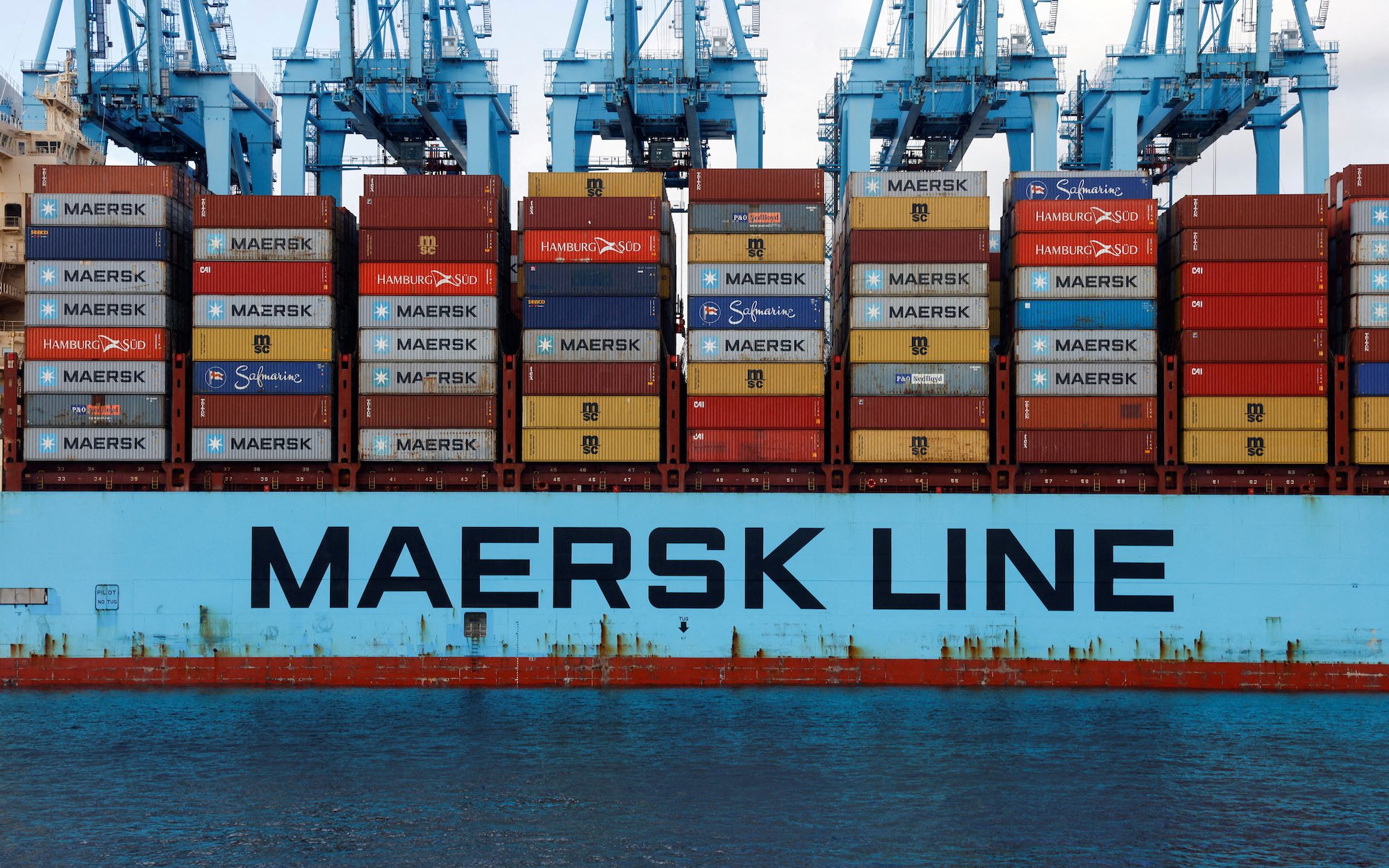
Albania Probes Toxic Dust Due Back in Europe After Outcry
(Bloomberg) — Albanian officials say they are investigating how 800 tons of alleged hazardous industrial waste was shipped from its port without authorization, bound for Southeast Asia, as the suspect cargo...

Indian Port Workers to Wage Strike for Better Wages, Benefits
CHENNAI, India, Aug 19 (Reuters) – A group of Indian port workers’ unions has called for a strike from Aug. 28 to demand immediate settlement of pay revisions and pension benefits, according to a...
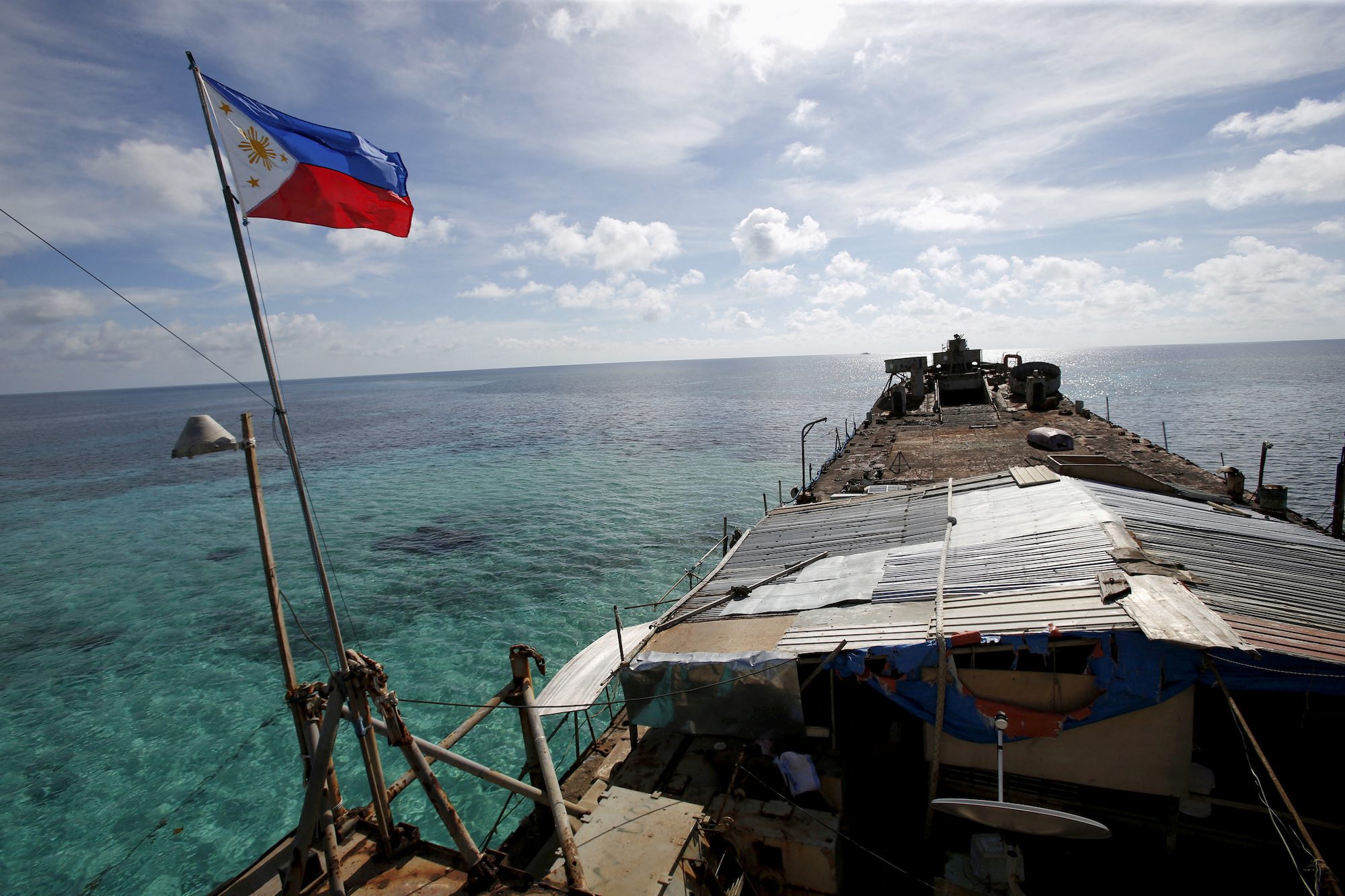
China Says Philippine Vessel ‘Deliberately Collided’ With Chinese Vessel
BEIJING, Aug 19 (Reuters) – China’s Coast Guard said a Philippine vessel that had ignored its repeated warnings “deliberately collided” with a Chinese vessel in an “unprofessional and dangerous” manner in the disputed South China...

Why Join the gCaptain Club?
Access exclusive insights, engage in vibrant discussions, and gain perspectives from our CEO.

OUT AT SEA?
We’ve got you covered with trusted maritime and offshore news from wherever you are.
JOIN OUR CREW
Maritime and offshore news trusted by our 108,426 members delivered daily straight to your inbox.
Your Gateway to the Maritime World!
Join our crew.

Privacy Overview

Carbon Mast Technology
A carbon rig is much stronger, stiffer and lighter compared to alloy. Therefore, it gives much safer and smoother sailing (conditions) experience as well as superior performance. Due to resistance to corrosion and a high reparability in case of damage, it also has a much longer lifetime.
The 20+ year experience and the unique technology introduced by Pauger made our top quality carbon masts, booms, vangs and spinnaker poles a serious and cost effective option to replace alloy rigging.
Standard specification
We offer complete rigging including masts, booms, standing rigging, spipoles and our award-winning vang innovation.
- Via our online carbon rigging inquiry sheet we are normally able to send you a preliminary offer within 5 working day . This offer includes the main specifications of the rig suggested by our engineers.
- Made of high-strength carbon fibre pre-preg.
- Production technology: female moulding, with internal pressure bag at 5 bar, cured at 100°C.
- UV resistant painted finish (standard colour: mat black).
- Bonded carbon mainsail groove or alloy Harken/Antal mainsail track.
- Carbon masthead and airfoil shaped, low-windage Carbon spreaders.
- Uniform and durable, maintenance-free fittings from BSI, Bluewave, Harken and Pauger.
- CNC-machined cut-outs for the fittings.
- Carbon Rod, Nitronic50 Rod standing rigging or Python© dyform.
- Once you confirm the order, the production is scheduled.
For more info, please download our mast brochure and carbon mast catalogue .
Check out our carbon mast references


1. Get a quote
Please leave your contact details below and our team will be in-touch with more details. (No spam guaranteed)
2. Enter your details
Please contact our team at 09 810 8406 and we can help with large order pricing and more. Alternatively, please leave your details below and our team will be intouch.
3. Thank you
We have received your details and our team of experts will be intouch within 48 hours.
Carbon Masts & Spars manufactured in Spain & New Zealand
Our roll-wrapped prepreg carbon fibre composite tubes are ideal for applications that need the highest strength and stiffness along with lowest weight. Typical industries that use carbon composites are marine, robotics, aerospace, automotive, medical and UAV/film.

All Products
Carbon fibre sail battens.
We design & fabricate premium carbon fibre sail battens and have a reputation and the world leading sail battens manufacturer. Providing professional teams, circuits, superyachts, dinghies with carbon fiber battens and hardware. Get in touch with our experienced team to discuss your sail requirements and get a quote.

Carbon Fibre Tiller Arms & Extensions
C-Tech have custom-built over 4,500 carbon spars in the last 10 years. From dinghies to foiling sports boats and multihulls, we have worked with a range or projects including production runs.

Carbon Fibre Plates
All C-Tech carbon fibre plates are laminated using the highest quality pre-preg fibre and cured in our autoclave resulting in an aerospace grade product.

Carbon Foils
C-Tech has expertise and capability to manufacture composite foils for any application. Design, tooling manufacture, fibre cutting, lamination, autoclave cure and painting can all be done in-house using the highest quality materials.

Carbon Fibre Masts
C-Tech has custom-built over 4,500 carbon spars in the last 10 years. From dinghies to foiling sports boats and multihulls, we have worked with a range or projects including production runs.

Carbon Fibre Booms
C-Tech manufacture a range of carbon fibre booms and sections for different classes. See each class section for their specific products.

Carbon Fibre Spinnaker Poles

Carbon Fibre Prods & Bowsprits

Get in touch

Carbon Fiber Masts an Affordable Option on a Tartan
Far from ordinary.
How does a Tartan sailboat outperform the competition? One important aspect is their carbon fiber mast. Every Tartan sailboat is available with a very affordably priced carbon fiber mast. Read on to see how this high tech mast translates into improved speed and handling and adds value to your Tartan.
Light and Fast

This lower center of gravity results in a smoother ride, especially through rough seas or choppy waves, and allows the yacht to carry more sail area. In other words, the lower center of gravity lowers the amount of heel for the same amount of sail area, effectively making a Tartan yacht able to benefit from more sail area. A lightweight carbon fiber mast also has the added advantages of being easier to step and/or remove for storage, shipping, or inspections.
Factors of Safety
A carbon fiber mast enhances safety on several fronts. An additional benefit of the reduced weight includes an increase in your Tartan’s range of positive stability. This is an important consideration when venturing offshore. Further, the mast itself is engineered to exceed physical requirements.
Sometimes the idea of a carbon mast brings to mind the image of a failed racing experiment that was built with little to no factor of safety. Our masts are built with laminates engineered to reduce weight while increasing the factor of safety and ability to handle loading above anticipated conditions.
Lower Maintenance
It isn’t every day that you find something that increases performance while lowering maintenance, but that’s just what a carbon fiber mast does for your Tartan yacht. Carbon fiber does not corrode or weather. This is especially helpful with regards to the severity of the sun and salt, making carbon an obvious choice for the marine environment. In particular, painted carbon fiber requires minimal maintenance.
This is why all Tartan carbon fiber masts are painted. It would be nice to show off that carbon fiber appearance, but clear coated carbon doesn’t offer the same low-maintenance resilience with regard to its appearance. Paint flaking from carbon fiber is extremely rare, making a painted carbon fiber mast sleek and shiny for a long time to come.
Increased Longevity
Part of the appeal of a Tartan yacht is its ability to last through numerous owners and generations (if anyone is willing to give theirs up that is!). This philosophy extends to the carbon fiber mast as well. Building out of carbon, which is stiffer than aluminum, is an effective way to stretch the life of the mast, offering increased longevity. Why? Carbon fiber masts are stiffer than aluminum masts.
While you may not immediately associate this with increased longevity, the result is that carbon masts do not repeatedly bend and twist as an aluminum mast would. All of that bending and twisting of an aluminum mast adds up to a lot of fatigue over the years. The added stiffness of a carbon mast, exactly where it is needed, results in a substantially lower fatigue rate. Carbon fiber masts are estimated to last, and retain their strength, twice as long as an aluminum mast.
Carbon Fiber Mast Cost
At this point, you may be wondering why every yacht doesn’t have a carbon fiber mast. In most cases it boils down to cost. A carbon fiber mast typically costs 3-4 times more than an aluminum mast. If a carbon mast is offered as an upsell, it is at a premium expense.
On a 40-foot boat, a carbon fiber mast could be more than a $40,000 upgrade. However, at Tartan Yachts, we offer a carbon mast at a small upgrade charge over aluminum. In addition to being able to enjoy the benefits of a carbon fiber mast, Tartan owners are able to hold their yacht’s resale value due to their increased longevity and added value built into the carbon mast.
The Bottom Line
So, how does this all add up to increased performance and speed? First, there is the weight savings. Second, there is the lower center of gravity advantage that allows for a smoother, more comfortable ride and for more sail area to be carried. Third, the added stiffness of carbon fiber masts ensures the mast does not bend, twist or vibrate as much. Think of the power available from the wind as a finite amount.
All of that extra motion in an aluminum mast is using up the available power. A carbon mast more efficiently transfers the force of the wind directly into boat speed. We design our carbon fiber masts to have this additional stiffness, but still retain enough bend to allow for easy rig tuning. This gives the yacht controllable power. Each of these advantages alone would result in an obvious difference in speed and feel, but we take it one step further. Carbon fiber masts can be engineered, through different fabric weaves, orientations and thicknesses, to behave differently at different sections of the mast.
Instead of a uniform cross-section, each mast is custom engineered for optimum performance for that model’s sail plan. With the correct techniques, competitive sailors can adjust their rigging, sails, and sail trims to utilize this engineering in conditions from light breezes to heavy gusts. A fully engineered, optimized, carbon fiber mast can truly outperform the competition—and that is why Tartan does.
If you have questions about the construction of our carbon fiber sailboat masts, please contact a Tartan specialist today.
Attainable Adventure Cruising
The Offshore Voyaging Reference Site
- Carbon Fiber Mast, Costs and Benefits
In the last post I explained why we replaced our old aluminium mast. This post gets to the real meat: How much did carbon fibre cost? And what did we get for that money?
The new mast, excluding some new rigging, cost about US$55,000, as against an aluminum replacement mast, which would have cost about $30,000; a lot of money to us, particularly since it was capital we were spending that came from the sale of our house.
Login to continue reading (scroll down)
Please Share a Link:
More Articles From Carbon Fibre Spars:
- The Benefits Of Carbon Fibre Masts
- Carbon Fibre Masts, Amateur Boat Design
- Carbon Fiber Masts and Lightning: Myths, Assurances And Risks
- GMT Carbon Mast, Problems
I’m confused… was the new mast 55k or 25k?
The new carbon mast was US$55,000. A new aluminum mast would have been $30,000. So we paid an increment of $25,000 for carbon over aluminum.
Any data on how long an aluminum rig will last? Ours is 30 years old and we are on the fence about just sleeving the area near the vang attachment that is cracked and re painting or maybe going with a carbon rig. It’s a lot of money to be tossing around when the diffemce could be a few years more crusing or the rig not holding up.
Hi Michael,
That’s a hard one. The issue is generally not really the age of the mast, but rather the number of cycle loads and how big the cycles are.
I really don’t like the sound of the cracks at the vang attachment, since this is a very difficult area of the mast to repair without causing hard spots (I’m assuming a keel stepped mast here).
Of course it could just be that the original vang attachment point was undersized for the loads (a very common problem) and a good strong repair sleeve, combined with beefing up the vang attachment and spreading the loads better will solve the cracks.
The problem is that it is very difficult to find some0ne with the engineering and rigging skills to do a repair like this properly—there are plenty of people who will claim to have these skills, few that do.
One thing I do know. Don’t let anyone talk you into some type of welded repair, not a good idea because of the way aluminum alloy changes when welded. If I were doing it, I would go with a long inside sleeve coupled with a patch on the outside, both carefully formed to exactly correspond to the curves of the mast (not easy) and then screw the whole thing together with a staggered pattern of stainless steel machine screws. But then I’m neither an engineer or a mast builder, so that might be wrong.
We kept out old mast going for a number of years with repairs like this, but I never really trusted it.
I’d just like to support every word John says here, and throw in my 5 cents, or some. 🙂 I’ve mostly had my mast fracture problems on utterly extreme racing rigs. They are not directly comparable, of course, but they do tell you what works, and more frequently, what doesn’t. 🙂 What I’ll say, will to some extent repeat what John says, with some variations. I do that to keep the explanations complete.
First, when there are cracks in a mast tube, not only is the crack itself a weakness, but stuff has happened with the metal. Probably that whole part of the tube is quite brittle from fatigue loads. Making that “as good as new” is not possible, but it’s possible to make it work. A rather long insert that follows most of the inside of the tube is the main element. I’d say in a spot like that, I’d use a piece at least 1 metre/3 foot long. Preferably more. You probably have to make the insert from a piece of the same profile, cut off the rear end (with the sail track) and split it in the front. Use a file to round off the edges a bit. Makes the job easier. Do one side of the mast at a time. Spread some rather thick putty on the insert that will make the insert support the tube well. Epoxy is a good base that doesn’t get too brittle with time.
When the insert is in the right spot, have some means of pushing it hard towards the tube. I have found that threads in alu tend to corrode, so I don’t trust screws. I prefer “monel” steel pop rivets. Do NOT use aluminium rivets. Way too weak compressive force. Use the largest type, 6,4 mm. Make sure they are long enough. It’s smart to have two different lengths. You need a serious riveting tool. The amateur stuff won’t last the whole job. The hardening of the grip teeth isn’t good enough.
Put the first hole where the insert is already tight onto the tube. Gradually work your way out from that spot. Drill, rivet, drill rivet. This will use the rivet tension to pull the insert hard towards the mast tube. The pattern should be so that you try to avoid the perforated paper effect. Distance between rivets maybe 10 cm/4 inches, but that will vary with mast dimensions, metal thickness. There will be a lot of rivets! When finished, remember to hammer out the nail head from each rivet. Otherwise it will rust and damage the rivet.
An outside patch where the spot loads occur (like the vang attachment) will not increase the mast stiffness, but will spread the spot load so the mast can cope better. The patch doesn’t need to be very big. It also needs putty to make the mechanical contact good.
If my description didn’t already make it obvious, this is quite a lot of work with no guarantee for everlasting happiness. My advice would normally be: Get a new mast tube, but if that’s too expensive, this fix is something you can do yourself and it probably, but not certainly, will keep you sailing for a long time.
I would totally agree with that repair modality, and your final conclusion.
Thanks for the advice. The previous owner of the boat had made a new vang attachment years ago and the engineering was off causing stress cracks. Turns out the attachment/pivot pin was too far from the rig allowing for more leverage than was ever anticipated.
On the repair. We feel our rigger will be able to do a fine job. What we don’t like is spending half of what a new rig would cost on the refit of the old one. Cheap route is to go with the old but as you know that decision could be the expensive one in a few years.
If you are faced with spending half the cost of a new rig, I would definitely go new. Just about every time we have spent that kind of percentage on refurbishment we have regretted it. Also, fitting a Carbon rig will almost certainly increase the value of your boat by an amount over half its value, when compared to the same boat with a thirty year old repaired aluminum rig. At the very least, it will make the boat easier to sell when that time comes.
Hi John, I enjoy your website and have learnt a lot of very useful stuff. I wonder if you have tried hoisting a bag of sand or some weight to ease the jerky motion mentioned in windless conditions? I’ve reduced my halyards from 12 mm to 8mm and noticed a difference and this is on an 10 ton ferro double ender! Thanks for the effort to make this site such a great read. Pete.
No never tried hoisting a weight. I’m guessing that it would need to be at least 100-pounds to make any difference (the new mast is 600-pounds lighter than the old) and go all the way to the top, or be at least 300-pounds at the CG of the mast about half way up. The thought of either weight crashing around up there would scare the hell out of me!
Lifting a rubber coated weight to the top of the mast with a T slot attachment that goes into the main sail’s track should work, you can store it in the bilge area when not in use.
You could even make a fiberglass anchor attachment that would put the anchor into the main sail’s track, keep it from moving around, and protect the mast from scratches, and lift that as high as needed.
It’s really not a big enough problem that I would want to go to all that trouble to fix it. Wrestling a 100 pound weight out of the bilge and on deck and then hoisting it up the mast as the boat pitches around offshore would be a really good way to get hurt.
Hi. A novice here. I’m shopping for my first boat to refit on the hard for a few years. I’ve found a cat with a Aero Rig manufactured by Carbonspar. I’ve never seen this before (which is why I happened upon your site). Any feed back on this product? I see that you mention that cycling loads are the best indicator of wear, for any material. Any idea how much longer a carbon product will last over aluminum?
Thanks, Greg
I had a long chat some years ago with the owner of a boat with an Aero Rig. He was not at all happy. He was also not able to sell the boat for years because of the unconventional rig. I would suggest a more mainstream boat for your refit effort. Also, you will want to read this post and the comments before going further.
Hi Greg, If you are thinking of a catamaran as a first boat, give my friend Kurt Hughes a call and pick his brain before you make that leap. http://www.multihulldesigns.com/
And if the aero rig cat that you are looking at is the one for sale south of Seattle that has had several million poured into it and never launched, you might want to invest in a pair of NIKE’s running shoes instead.
This is way too late for any advice on buying this specific boat. Also, I’ve never actually sailed an Aerorig. Still I have some comments on it.
I’m a multihull fanatic and loves the unconventional too, so I should like it, but I must say I think the Aerorig is a misunderstood solution to the wrong problem, and especially so if put on a multihull.
It’s great to be able to depower at any angle of sail. It’s also great to have the rig balanced so sheet loads are low. The aerorig has both, but the lack of supporting stays and shrouds mean the rig is ridiculously heavy, expensive and still very soft. This means it’s impossible to get a good and stable sail shape.
The claim for superior efficiency, is mostly quite significantly the opposite. The much narrower slot between main and jib means serious loss of efficiency. Downwind this is better, but it seems much of the thought behind this rig is based on a misunderstanding of aerodynamics combined with overconfidence in carbon fibre, which is an amazing material, but not magic.
Ciao Greg, in the past i ‘ve been interested in the aerorig concept so i bought (super cheap)an open 30 sporting such a rig.Afther one summer in the med i was lucky enough to sell the boat without the rig wich is now burried 3 feet under ground in the Eolian island ,Sicily.My humble suggestion is to consider a different option Giancarlo
I’ve been experimenting with weight aloft because of a sharp motion in a beam chop. Mine is an Atkin’s “Thistle” though in ferro cement. Her mast is about 2 metres shorter than the Thistle as shown on the Atkins’s website. So I hauled a 20 kg weight aloft on the staysail halyard and the difference to the motion is remarkable, much softer and slower. I will try a bit more weight to find the best compromise. I’m considering building a new mast for her in timber most likely a Junk rig but also considering an unstayed mast cutter rigged. Now it seems counter intuitive but my reading is indicating that more weight aloft is better for intitial stability, resisting knockdowns better so I’m thinking of adding a few metres to the mast and some weight which will make her motion much slower in a beam sea but may make her hobby horse some more according to John Vigor in ” The Seaworthy Offshore Sailboat”. Its amazing how much weight aloft affects the motion, 20 kg on a ten ton yacht and the effect is remarkable!
I would strongly suggest that you consult a qualified naval architect before making such modifications. Yes, a heavier mast can increase the dynamic moment of inertia, but it will also decrease the angle of vanishing stability and increase the chance that the boat will remain inverted once knocked down. This is not a case where if some is good, more is better, but rather a trade off situation.
In fact, as any commercial fisherman can tell you, a nice slow comfortable roll can be a sign of impending disaster due to too high a center of gravity.
I have written more on this subject here .
Its pretty common knowledge how to engineer a freestanding mast and I’m trying to get it back to the size as drawn by Bill Atkins so can’t see too many problems in regards to strength. The weight is another matter and thats why I’m experimenting with weight aloft. I lash the ignot of lead to the inner forestay and hoist it with the staysail halyard. I’m aware of the dangers involved and take great care. SAD on this old girl is around 13! So she needs more ooomph in light air! She’s a bit like a Bonzai Tree, pruned to the wind force in Wellington , NZ which is something. So I would like to find what affect various weights have and when I settle on a motion and performance I like I’ll try to build the mast to that weight. I’m thinking I’ll need to add weight, not try to build with less due to the lack of rigging. I’m concerned with making the rig too light and having to live with a really lively motion. From this experiment I can see that a tube in the mast into which water can be pumped would make the yachts motion quite adjustable by which one could make her better to windward by draining the water, more comfortable at anchor or in a following or beam sea by having more weight aloft. In regards to stability, a timber mast, unstayed, would float so making it more difficult to invert the yacht by adding positive buoyancy to the vessel at more than 90 degrees. So lots of positives here John, more resistance to capsize, more comfortable motion and maybe less inclination to invert than an all metal rig plus more sail. Now if only I could figure how to make the mast rotating! 🙂
I enjoyed your post. You gave the pros and cons of the two different types of mast. And that is important.
Is there anything that could be done to reduce the uncomfortable motion when you have to motor?
Wayne TexasGrizzly.net
Well first off, the increase in motion while motoring due to the carbon mast is not that marked and only in the roll plane. Pitch is actually better. I only mentioned it in the interests of completeness.
I really can’t see any practical way to have the benefits of carbon and the benefits of a heavy mast at the same time, it’s just another one of those compromises that goes into boat design.
The bottom line is that, for us, carbon’s benefits far outweigh this one small drawback.
Fascinating thank you. Regarding motion and comfort, it sounds to me that you may have gained a significant comfort benefit from the yacht’s enhanced ability to punch through head seas rather than be stopped by them. In my experience the deceleration-acceleration cycle that results from head seas is much more likely to induce seasickness than any other form of motion.
Like many other commentators I started thinking of hoisting weights to slow down the roll when the seas are larger than the wind. I hear your arguments against it but perhaps lowering a centre-board is an alternative (for boats so-equipped).
A Boreal 47 with carbon mast is looking pretty attractive, albeit expensive [but not unjustly.] Will the [less expensive & smaller] A40 have a carbon mast?
Counter intuitive I know, but dropping a centreboard will make the roll more acute and more uncomfortable, not less so.
And no, the A40 will not have a carbon mast. The cost benefit trade off on a boat of this size and type is just not compelling.
Thank ou for a nice book about carbon rigging!
I am going to change my alu-mast for carbon. Which typ off standing rigging do you use with your new mast? Rod, Dyform or …….. We are planing sail away the summer off 2017.
Hi Gamenius,
We stuck with rod, because our boat, including chain plates, is all sized for that.
If I was starting from scratch with a new boat I would go Dyform.
Why are you changing the rig to carbon? We only made the change because our Aluminium mast was badly cracked due to a poorly executed joint.
Thank you for swift reply
My rigg is just 6 years old, so we do not need to change. But last year we did som service on our boat, and we had to remove the mast. The weight did shock me, and I decided to chance for something lighter; carbon.
We do not have to change the rig, but I want to do it before our trip.
We do have a local firm doing nice rig-jobs. They are normaly working with Sparcraft and selden, but when we started talking about carbon they told me that we should get a new rig from a producer who knew carbon. They also liked Hall, so we are going to talk to them.
And why do you like Dyform better than rod?
Because terminals can be easily fitted in the field to Dyform. Rod, on the other hand, requires specialized equipment and a skilled operator to terminate. Rod is also a bitch to handle when your layup or commission the rig.
Hum, I don’t know your boat, but I would be careful about just replacing the rig with a lighter one without doing a lot of investigation. Lighter is not always better. Also, adding a lighter carbon mast will increase the load on all parts of the rig: stays, winches, sheets, deck gear etc.
Therefore it is important to consult with a qualified naval architect before making this change.
Thank You for your advice. I will consult the designer ore the shipyard.
My boat is a RM, a very stiff and strong boat, made of plywood. She is light and fast, designed by Mark Lombard.
Another alternative that might complement your carbon mast at a cost about the same as Dyform and less than rod.
http://www.sailmagazine.com/diy/ask-sail/dynex-dux-fiber-rigging-after-6000-sea-miles/
I have never heard about Dynex Dux fiber rigging before. I am not sure that I would go for a product that unknown for me. Who are selling this stuff, and who produce and sell it?
Hi Markus H (Gamenius) 🙂 I’ve also not heard about the brand Dynex Dux, but I’d guess it’s just a branding of normal Dynema rigging. This has become the standard in extreme racing like the ORMA 60, 75 and IMOCA 60 classes. These boats go pedal to the metal solo even non stop round the world. The reason often given for choosing fibre rather than metal is better reliability and easier to inspect.
They do need exchange approximately in half the time compared to a good steel wire rig, but since fibre rigging is cheaper to buy and easier to rig, total cost in the long run is normally about the same.
You know Marius Rosvold. He’s used Dynema shrouds on his 40 foot cat for about 10 years, and knows a lot about fibres in general, including carbon masts, as he used to manufacture some of them. Talk to him about the experience. I got his phone number etc if you want it.
Hi Richard,
Do you have first hand experience with Dux rigging? If so, I would love to hear how it worked out. We will need to replace our standing rigging in the next few years and I definitely plan to look into it. While I don’t like the idea of the extra windage, we have a very heavy rig which contributes to the boat pitching more than I would like. Realistically, I will likely ended with regular wire again due to not being an early adopter type but if it really is proven by then, I would be very interested.
Hi Eric, I have no personal experience with Dux— that is why I included a link to someone who does. Brian Toss in Port Townsend has also rigged several boats with it and is well respected.
Thanks Richard. I occasionally, look at the stuff the Brian Toss posts on it. He seems to think that it is the way of the future which is interesting and he clearly is quite knowledgeable. Once the number of installations is up and a lifespan is established, I will feel a lot more confident in it. It would be interesting to see what the insurance companies think.
For me the amount of rough use that the material has undergone as bottom trawl line weighs in as strongly as typical yacht use— ie sitting in a marina.
Doesn’t seem to have taken the yacht world by storm , but that could be because it isn’t shiny or found on Beneteaus rather than whether it is a good material or not. And insurance companies are the last ones I’d rely upon for materials engineering. My experience is that they are good at extortion and lawyering their way out of paying, but not much else.
RDE I agree on your comment about well tested. On that note, it’s worth mentioning that the extreme racers like IMOCA 60, that all use fibre in their standing rigging, will sail a longer distance in a couple of months in a non stop round the world race than most normal cruising sailboats (not long distance cruisers) go in a lifetime. The waters they sail are the toughest in the world and they push the boats way beyond what any sane sailor would consider. The solutions they have are chosen because they are superior on reliability.
Racing boats and long distance cruisers are very different beasts, which is of course also a trawler bottom line, but I think they are still very convincing testing platforms. The solutions we actually use on cruisers cannot endure those same punishing tasks without failing miserably, while at the same time being more expensive and heavier.
It’s hard to know why it’s not entered the cruising market more yet, but I actually think the main reason is that a fibre rigging needs more frequent inspection and an interest for keeping an eye on how things are. I’d guess boat builders and riggers alike are a bit afraid they will get into trouble with warranty etc if they give the normal cruiser this responsibility.
I know of Rosvold and his fast TRT1200. I am not sure that Dynema is the right rigging for a long distance cruiser. But I might be old fashion.
The reason for me considering carbon mast is the weight saving. I was shocked to see the weight of ma alu mast. It was heavy! But I would like to have a rig that I could easily maintain in the pacific, far away from professional riggers.
Of the same reason I am a little bit sceptic to rod. If it fail it fails fast. No forewarning, I belive. But a lot of people I am talking to tell me that it would be stupid to pay for a carbon mast and not use rod ore some new fiber rigging. They compare it to install a V12 engine in an old VW Beetle. Am I stupid, just wasting money?
I really can’t see anything against installing a carbon mast with wire rigging rather than rod. The weight savings with rod is really not that much. Of course if you are seriously racing, then rod makes sense, but if cruising, I would go with preformed wire, as I said above.
By the way, that “breaks without warning” criticism of rod comes up all the time, but it is overblown. Most any failure on a rig that is well maintained and replaced in a prudent cycle “is a break without warning”. And a benefit of rod is that it lasts a lot longer than wire.
As to Dux, I’m with Eric Klem, sounds great, but I must see more history in the field before I would go that way.
Hi Markus. I think being a bit old fashioned is smart when planning long distance sailing, both cruising and racing. As frequently mentioned on this site, what has been tested by many sailors will offer reliability. Also old well-tested solutions are sometimes just better than newer ones.
Traditional sailboats mostly used rope for all standing rigging, lashings rather than shackles and no rigging screws. The most extreme racing boats on the planet have returned to exactly those designs because it’s lighter, stronger and most important: It’s way easier to inspect and maintain. A shackle can suddenly break without warning, maybe because of fatigue. A rope lashing will always show clear signs of wear and fatigue is not possible. It’s way better at tolerating overloads and unexpected pull angles.
I think rope in standing rigging is much safer than steel, but only if inspected and maintained regularly. Many sailors treat their boats like their cars. Do nothing until it won’t work, then call the mechanic. With that attitude, definitely choose steel. I know that’s not your attitude, so I’d definitely look at Dyneema or such.
The claim you’ve been told that you need rod to get the real benefits of carbon is just plain wrong. Rod is only smart if: 1. The boat has a quite narrow base for its shrouds, and 2. It’s a pure racing boat. If you remove any one of those conditions, another material will do a better job. As mentioned, the fastest racing boats on the planet use no rod, but they all have carbon masts. With your boat, none of the conditions are applicable.
Rod rigging is very cool for two reasons: It’s very stiff, meaning not stretchy, and for a given load, the rod is considerably thinner than realistic alternatives. Thickness matters on a racing boat because it means less drag, especially upwind. On a long distance cruiser, thickness matters much less. You can easily get the strength and stiffness you want from several other materials. I would say that you have two good options: Dyform or rope. Both will match a carbon mast very well.
The really big problem with rod is making terminals on them. The only really good alternative is a special machine that swages the end of it so it gets bigger and can’t pass the terminal. Most riggers don’t have such a machine and rely on inferior methods.
The cool thing about Dyform is that it’s almost as stiff as rod and almost as easy to handle as normal wire. Normal wire is made from hot rolled steel. Dyform is made from a higher steel quality and then cold forged. The latter gives the hexagonal shape that makes a denser wire and the metal gets very much stiffer. I’d avoid swaging. The process tends to damage the effect of the cold forging, making the exit of the swage an even bigger weakness than with normal wire.
A carbon mast is mostly easier to fix than an alu mast. If it breaks, it can be repaired to 100% of new, which is impossible with alu. The repair takes some knowledge, but the amount of work and skill is less than for the alu mast repair I described further up in this thread. You would need normal woodworking tools, suitable carbon fibre, epoxy, adhesive tape, gloves, etc. Easy enough to bring, and much less space and weight than what you need to fix an alu mast. To find a rigger that is actually competent in repairing an alu mast, is not easy anywhere, and as mentioned, will never be a fully good mast. Go for carbon without doubts of suitability. The cost is considerable however, so if it’s worth exchanging a well functioning alu mast is a valid question.
Just want to add a bit to the above post, in spite of it already being ridiculously long. 🙂 When I say “rope rigging”, I do of course mean stuff like Dyneema, PBO, the mentioned DYnex Dux or similar tings specifically meant for standing rigging. Normal “rope” is not suitable for this type of use.
Many of the extreme racers that use some sort of fibre rigging have no spreaders. Just like traditional rig types. This makes the rig very simple and is possible on very wide boats, which almost all extreme racers are now.
Most cruising monohulls are too narrow to make this possible. One can still use Dyneema etc, but I think I’d mostly go for Dyform if I wanted to optimize the standing rigging of a normal cruising monohull. On a multihull I’d never be in doubt: Choose “rope”.
Rereading my long post above I notice that I have written another word than I meant to write. In the part about making end terminals on rod, I say the good method is to use a machine that will “swage” the end of it. What I meant to say was “forge”. I have to admit I’m not even sure that’s the right word. English is not my first language, so I make some mistakes like that.
The process I’m thinking of is reshaping the steel by brute force without heating it. This will make the steel more “compact” and increase strength ans stiffness. Both rod and Dyform have already been treated this way, so terminals need to be right.
I got the last edition of “Mechanical and Electrical Manual” by Nigel Calder some days ago. It is all new. I have read the second and the third edition, but I did really missed an update. Now the forth edition is here!
In the section about standing rigging Calder writes a lot about Dynex Dux. Both he and his son has used it on this boats. They liked it, but it creeps and they need to tension often. It is also prone to chafing. The main thing is 1/5 of the wire weight. Twice the strength for the same diameter. Easy to inspect, change and repair.
The big questions are if the Dynex riggs will hold up as long as wire and that creep does not be an issue under normal use.
I am tempted but not convinced
I think, at least for me, the chafe issue might be a deal breaker. The thought of the potential disaster just because a crew member was careless running say a sheet and said line worked against a loaded shroud all night in heavy weather without anyone noticing is just too scary.
Also, the creep would drive me nuts! I spend a lot of time tuning our boat and getting everything just right. Having to redo that process regularly would be a deal breaker on its own.
Bottom line, like you, I’m going to need to see a lot more realworld use before I would be willing to go that way.
Radar and carbon
I have my Simrad Broadband 4G-radar on the arc all the back on my boat.
Someone told me that carbon is a bigger issue for the radar than aluminium. Will the mast be a problem for the radar signals?
We have not seen any appreciable mast shadow from the either our carbon mast, or the aluminium one that we had before.
Also, I really can’t see any logical reason that carbon would be worse in this regard. As I understand it, both materials are essentially opaque to radar signals.
I’m guessing that the reason that this is not a big problem is the fact that the transmitting array is wider than the mast is.
Carbon is generally a bit less reflective to radar than aluminum is, but not enough to make any difference to the performance of your radar. You can usually see past either kind of mast without a problem. Incidentally, the Simrad FMCW units are sensitive enough at very close range that you can sometimes see the mast on the radar display. I even saw one once that picked up the boat’s own fishing outriggers, along with the individual pilings of the pier.
To day I have a trysail on a separat track. I would like to keep the trysail, but I do not like the weight of the extra track. Harken offer a system called “Trysail switch”, where the trysail uses the mainsail track. Is this any good, ore should I look for another solution?
An interesting gadget, I agree. Having said that, I like the independent backup provided by a separate trysail track. The point being that to me one of the biggest reasons to have a trysail is in case the mainsail or the rigging used to set it are damaged—that includes the track.
Further, I can’t see that the weight of the trysail track is that significant since it’s relatively low on the mast. The key point being that when we think about weight in the rig it’s not very useful to focus on absolute weight. What’s important is lever arm multiplied by the weight. For example, saving say 10 pounds at the top of the mast can be a lot more beneficial than the entire weight of a trysail track further down.
So, in summary, If I were running a full on race boat, I might worry about the weight of the trysail track, but not for a cruising boat.
Thank you for all your replies
So you have a separat trysail track? Then the mast should be prepared for that track? It is not something you can add later on a carbon mast?
Yes, we have a separate track and even a separate halyard, so we have total redundancy.
Adding a storm trysail track to a carbon mast later is very tricky. The key thing to understand is that carbon has very poor thread holding due to a property called bushing. The result is that a highly loaded track like the storm trysail should have an aluminium backer plate. You can learn more about how NOT to build a carbon mast and the bushing issue here .
And you can read my thoughts on storm trysails here .
I support what John says, and would also say that I would feel a bit uncertain about that thingy actually being able to work in really bad weather. That lack of trust got a lot worse when I read in the description: “Cars must not be under load in curved section.” When a trysail is needed, you’re probably quite stressed because of a lee shore, big waves and way too much wind. All slides will be under load most of the time, sometimes very high load from flapping. I’d feel very uncomfortable having to rely on a little gadget like this.
I would agree. I long remember standing on top of a winch struggling to thread the slides of a trysail into a gate above the main with it blowing storm force. It took three strong young guys over an hour to get the sail set and was one of the most unpleasant experiences of my sailing life.
What is the real weight saving?
I have been reading “some” posts about carbon rigs. Some of them are claiming that the real weight saving is not big at all. The reason for this is that the standing rig is heavy and that all terminals connecting the standing rig to that mast are heavy to. So all in all you will at best have a weight reduction of 20, but probably not more than 10-15%. Is this correct?
The weight saving on our mast was a bit under 50% on the mast without standing rigging. With standing rigging it’s about 25%. And our rig is 100 pounds heavier than most carbon rigs would be, because we upped the strength. So the summary is we got a much lighter rig and a stronger and more durable one, at the same time.
The thing is that the percentage weight saving is really not the right way to look at it. The key to making the decision is to examine the effect the weight saving will have on sailing ability. The point being that even 10% can have a huge effect. Also, carbon masts have a lower centre of gravity than aluminium ones because the tube wall does not need to be as thick at the top as at the bottom.
Anyway, I have a full post here , that explains the effects of any weight savings.
I can also tell you categorically from real world experience that positive effects (as detailed above) on our boat were, and are, immediately noticeable and substantial.
I’ve also heard the objection with how many percent of what is saved. My opinion is that it’s a completely irrelevant comparison. The point is just that getting 200 kilos off the rig is great, no matter what other weights are there. The percentage is meaningless as an expression of effect. A story from our own Norway illustrates that:
Our present King Harald has been an eager racer his whole life, and good at it too. In the eighties the IOR classes were the hottest, and the IOR One Ton was definitely king on the hill. 🙂 Harald was Crown Prince at the time and launched one of the best racing campaigns in Norwegian history, aiming to win the World Championship in Kiel. This contained a huge amount of preparations and considerations, but one little detail was quite interesting:
Wind instruments was seen as an “of course!”, until the designer said “are you really really sure you need them? The sensor thingy at the mast head is 0,7 kilo and the wire up there is about the same. It’s really far up!” The answer most thought of was in the line of “yeah, but on a mast this big and with all the wires, sails and stuff up in it, that’s nothing!” But then the designer said that “OK, but to compensate for that, I have to add 76 kilos at the bottom of the keel, and I should reshape the bow and stern some to compensate the heavier pitching.” There were no wind instruments on the boat and they went on to win the championship. That single choice wasn’t the reason, but that line of thought was.
I have a suspicion that many sailors want to have the feeling that they have the best possible solutions on their own boat. When discussing other solutions, they tend to make an effort to discredit them. I can’t see any other explanation for bringing out the point about the percentage of the total rig is saved. I kinda wonder why they also don’t point out how small a percentage it is of the whole boat weight. “Just one percent maybe? And how much were you going to pay for that tiny percentage?”
In this case we have to keep the topics separated. Saving weight up there is extremely much more effective than anywhere else in the boat. If the rig as a whole, including sails, have then actually become only 10% lighter, it sounds little, but that will actually make your boat behave at least 10% better and 10% faster, etc. That’s pretty impressive!
In the nineties there was a rush of racers that changed from aluminium to carbon. I was amidst that and it was interesting to look at numbers and effects. I didn’t take notes, but I’d say as a general guideline the mast tube would lose between 50 and 60% of its weight and still be much stronger.
One boat I sailed (Formula 28 trimaran XOZ) had a 105 kilo Proctor alu rotating semi wing. We changed into a Marstrøm mast with the exact same shape (developed for our boat). It was 28 kilos and still a lot stiffer than the alu tube. Marstrøm did use higher modulus carbon on that one though. Much more expensive. It’s possible to make ridiculously light stuff that will take a serious beating, but it will cost.
If you need a new mast, there is no doubt that carbon will serve you a lot better than aluminium, but if your present mast is goood, I doubt that it’s economically smart to change it. It will definitely make your boat better though, to a degree you will have zero problem noticing.
John seems to be a man not prone to exaggerations. In his description of how Morgans Cloud became a better boat when she got a carbon pole, he says very clearly how good a choice that was. I think that verdict has a credibility rating of “sky high”! 🙂
Great analysis, once again. I love the story of King Harald, really makes the point well. And, sadly, I think you are right about the reasons that some people bring up arguments like the percentage one, that make no sense.
I also agree that for a cruising boat a carbon mast is really only worth it if a new mast is required anyway. This was the case with us because our old mast was full of cracks from a poorly executed joint.
Great story. I can now use this as an excuse as to why we have no wind instruments. The only problem seems to be that my wife insists that I chronically underestimate the windspeed. I really like the tall rig on our boat in most conditions but we have a lot of weight very high up and I am convinced that this is a major contributor to the pitching we experience.
The reduction in pitching has been the biggest of the many benefits that we got from our change to carbon, and MC was never a bad boat for pitching. Interestingly, it is most noticeable when motoring up wind into waves, when the change is miraculous.
Partly inspired by this thread I switched from an in mast aluminium furling mast to a carbon mast with slab reefing and a canoe boom. It was a radical step to take, when strictly the mast didn’t need replacing, but it was at a tipping point. She needed new sails, standing rigging, in mast furling motor had failed, mast needed stripping and painting as the anodising was reacting to the stainless fittings. All the fittings had been installed before Duralac so were bonding to the aluminium. And the mast pumped more than I was comfortable with. She sailed well before – now she is just much more enjoyable and faster. She weighs 21 tons, but she accelerates rather than heels in the gusts. Points 30º/35º apparent. Yet she’s perfectly balanced with minimal weather helm. 300kg out of the rig with the changes to the mast, standing rigging (rod rigging now) and switching to 3Di North Sails. Increased the main by 200 square feet. Financially tough to deal with, but glad I went through the pain. It does seem to be one of those performance improvements that is win win all the way round. Even sailing close hauled isn’t so much of a chore, and it’s satisfying overhauling those who are motor sailing with ease. In the Caribbean winter 2015, (doing the ARC). I’ll try and do a video for those interested. All best, David
Sounds like a really smart combination of upgrades with a overall system and simplicity focus I really like.
I would be interested in hearing how the 3DL sails work out over time.
You did take a bigger stepp up then I am going to. I do have a slab reefing and I am going to keep the geometry of the rigging, so I can keep my sails. The rigg is 6-7 years old and OK. It is the weight that is my biggest concern, so I am going to change to carbon.
I am getting prices from Axon, Hall and Selden. Who did you go for?
Went with Axon, installed by Advanced Rigging (Hamble Yacht Services) in the Hamble, UK, and very happy with the quality. Eric Duchimin does know his stuff. Think their setup is cost effective, French company, masts built in Romania. If you place an order at the right time of the year and are not a rush order you can negotiate. The one tip I’d give is sit down at a proper Autocad workstation to check out the details. Trying to do it off print or PDf’s isn’t that effective. The canoe boom I wasn’t sure of, but now I’ve got used to it – it works well. The ability to walk along the boom, sort out reefing lines, flaking the sail, sail cover etc is not to be underestimated. If you go carbon, think you also have to go hydraulic with vang and backstays. Till you have a carbon mast, you don’t realise how easy it is to adjust the sail set with these tools. It’s taken us a while to work out the correct trim for a reach, close hauled was easier and ironically faster for a while. When you do replace the sails – have a look at 3Di. They do perform well with a carbon mast.
Hi John, Stein and all of you
Just want to say thank you! It makes life and sailing easier when people are sharing good thoughts and their experience.
I am going to order my new mast in a few weeks. I want Hall, but they cost much more than Axxon and Selden. Axxon are, like Hall, a composite only mast producer. Bur they are very french, just like my boat 😉
For me Selden is aluminium masts, carbon, I do not know.
Hi Markus I have no knowledge of Selden carbon masts, but they are a big company that probably understand that they need to make good products to survive in the future, so I wouldn’t worry too much about competence compared to “no name” makers.
On the other hand, there is a point most customers lack a proper understanding of. Saying that an object is made of “carbon” is as precise as saying that an object is made of “metal”, but not if it’s steel, aluminium or gold.
Carbon exists in a very big variety of types. The properties and prices span extremely wide. The normal measurement is E-module (elasticity) given i MegaPascals. Normally the types are put in groups Standard, Intermediate, High or Ultrahigh Modulus fibre. I norally found it more illustrating to talk about elongation at break. Good quality E-glass (normal type) is about 5-7%, Standard modulus carbon normally is around 2%. The higher qualities can go as low as 0,02% or possibly even less. The price goes up very dramatically though.
In a mast it’s probably smart to not use too much standard modulus. Probably intermediate will give you a dramatically stiffer mast for the same weight and it will be more reliable too, but the fibre will probably cost at least twice as much. In the total cost of the mast though, the fibre cost increase isn’t too horrible. Comparing the different producers, I would ask for some pretty exact details on fibre types and layup processes. Some use single filament buildup with a machine. Do NOT go for that. Totally unsuitable for masts. They need to use mats that they wrap on or in a mould. They should also use prepregs, not wet layup. They should use a high temp cure system, at least 90 degrees Centigrade, preferably 120. They should use an autoclave, an oven with very high pressure, that compresses remaining air bubbles in the laminate, while vacuum will expand bubbles. Such bubbles are possible future weaknesses. Hall might even give you “more mast per dollar”, but to find out, you need to pester all the producers with detailed questions about the above topics and anything else you don’t feel you get quite.
I would also include at least two mast producers I know of. Marström http://www.marstrom.com/en/spars . They have more knowledge and experience with carbon than most other companies on the planet, as they started in the eighties. They have a “check” on all the mentioned points and can do things most other producers comment by “What? How did they do that?!” They built the majority of the Olympic Tornado catamarans, all the Extreme 40 cats, the Seacart 30, thousands of dinghy masts, big numbers of masts for bigger boats (their first one was for us, XOZ, which they later bought) parts for fighter planes, etc. I have been at their spots up through the years (but long time ago now) and they do serious stuff! The founder and owner, Göran Marström is an Olympic silver medallist (Tornado 1980), son in law of iconic Poul Elvstrøm (the most winning olympic sailor in history) and a smart and cool old guy.
Torbjörn Linderson used to work for Marstrøm and is now working for Southern Spars in Spain, or at least he was until a year ago or so. I can ask. They are certainly a very serious producer too, and he certainly knows all there is to know about carbon. I’ve used quite a bit of carbon myself, but compared to the serious mast guys, I have no clue. Southern Spars made the masts for extreme maxi raters like “Comanche” and “Wild Oats”, and all the Volvo Ocean Race boats. Should be good enough for credentials. 🙂 http://www.southernspars.com/
It seems that Southern Spars do not “like” small boats. They are so expensive that I think they are saying “no thank you” to customers like me.
I called Marström and did have a long talk with Per Wärn, who are working with technical sales and production. He told me that, as far he did know, most of the known carbon rigg makers did use good fiber and good production techniques. He gave me some good input on several things, like installing a lightning rod and copper strand, that is connected to the keel, installing a separat try-sail track, and so on.
I like small companies that have time to talk to the costumers! We are asking them to send us and offer to.
It would be cool to have a scandinavian mast!
Per (Pær) is a calm and nice guy and has been a core person with Marstrøm forever, so he’s worth listening to. He would never criticise his competitors. That will always backfire and leave a bad impression. He’s probably mostly right too. In the nineties there were some mast makers that had no clue and just wanted the cool carbon brand. Nowadays I think most have the knowledge and morale to make good products. Not all use an autoclave though, and not all use 120 degree C cure systems.
What I meant with my talk of different types of carbon is not to say that “Standard modulus” carbon is bad stuff. It isn’t at all! All carbon I’ve ever come across is really great stuff. I have no reason to think any mast maker would try to fool you. I think they will all be completely honest about all you want to know, if you ask.
What I did want was to give some basis for questions or specs. When you get price quotes, the fibre in the mast might be higher modulus in some expensive masts, even though they might not say that immediately, because they’d expect you wouldn’t understand the meaning of it and it might cause confusion. If you ask directly, they will of course tell you. A more expensive carbon is not better quality. It’s just stiffer, so you get different properties from your mast, like lighter.
Masts are perfect spots for using more expensive fibres, because the payoff in boat behaviour and speed from reduced weight is so great, and because they work under mostly compressive loads, which greatly favours very stiff materials. Less flex combined with less inertia means a stiffer mast gets lower local loads if all other factors are the same. Rudders and daggerboards are better in standard modulus fibre, since they need some flex to reduce peak loads.
I will send a message to Torbjörn Linderson at Southern Spars. I spoke with him less than a year ago and have sailed with him and known him for decades. It’s interesting to know from him if they are not interested in normal boats, or if they have a reason for being prohibitively expensive. He knows he can’t give me bullshit. 🙂
About installing a copper thread in the carbon mast. That might be smart, if Per says so, but it surprises me. Maybe I misunderstand? Maybe he thinks of the copper wire from the mast foot to the keel bolts? Carbon fibre is an extremely good conductor. Actually better than Gold, and naturally way better than aluminium. Maybe there is a problem with the epoxy still getting fried? If a copper wire is to be installed, one would need a seriously thick copper wire to make a difference. Right?
I have not been in contact with Southern Spars my self, but the firm I use in Norway have asked for offers on some project and they tell me that they do not do that anymore. Southern Spars are always the most expensive alternative, by far. But it would be interesting to hear why they are so expensive. It is hard to belive that they should be of much higher quality than Hall.
And you are right about Pär at Marström, he does not speak badly about his competitors. I really got the good “trusty” feeling when we did speak on the phone, so my gut feeling is that we are going for a Marström mast. But we have not seen any price, though we talked to them yesterday.
It could be me that misunderstood the details around the lightning protection Pär explained to me. But Pär had the same view about carbon masts and lightning as Hall has. He told me that they have some masts that have been hit and they survived just fine.
Lots of good points on modulus.
On lightning. You are right that carbon is a good conductor, but epoxy is not. That’s why it is very important that any carbon mast have a separate lightning conduction system. More here.
I ordered my new rigg earlier this week.
We did get offers from Selden, Axxon and Hall. Wa also talked with Marstrøm, but though we wanted a complete solution we did leave them out. They seamed like a good and serviceminded company, but in the end they wanted to make the mast tube and leave the rest to others.
We did find the communication with Axxon to slow so we left them out and continued the dialog with Hall and Selden. I got the feeling that I was choosing between two very different products.
Selden being the smart choice. Lower price (wrong to call them cheep), good quality, easy to get spare parts (using their standard parts) and many service places around the globe.
Hall being the choice of hart. High price, superb quality, maybe harder to get spare parts (they claim that “nothing will brake”) and most important the guys at Hall are real experts. They know rigging and we are getting answers and feedback fast.
So in the end I followed my hart, we are going for Hall. I really got the best feeling for their solution, even the higher price.
Thanks for the update. I think you will be very happy with your Hall mast. Please let us know how it works out once you have it stepped and have sailed a bit.
Hi John, I recently heard an opinion critical of carbon fiber as a spar choice that it could be challenging to find capable work/repair in remote locations. First, how true is that in your experience? Second, how often have you in practice found yourself needing work done on your CF mast in any location, remote or not?
Thank you & best wishes,
I guess I can’t really see that opinion as logical. After all, what work would we need to get done on a properly built mast, aluminium or carbon? (We have not done anything to our mast.) Generally, either a mast tube works, or it breaks and the mast falls down. In that case repairs are unlikely.
And even in that case, scarfing an aluminium mast properly is a highly skilled job that is arguable at least as skilled as fixing a carbon mast.
And finally, one of the advantages of carbon is that a properly built carbon mast is intrinsically more reliable than aluminum because carbon does not fatigue or crack, as aluminium can and does.
Of course all this assumes a properly built mast for cruising, not a racing carbon mast that may be engineered with razor thin safety margins.
Thank you John, I had my suspicions but have no experience with carbon fiber – great to hear it confirmed by your experience. The open sharing of knowledge and especially experience makes your site such a valuable resource!
Best, Chuck
In 2010, we switched to a carbon fiber mast for our Mason 44. One of the best decisions we made. Like you, we ended up working with Hall Spars which was a great experience.
Don’t know if you saw the latest news, but Hall Spars has closed their US facility. Lots of talented and very good people impacted.
Hope they can regroup.
Thanks for your website.
Glad the Hall mast worked out. As Ben Hall is want to say “cheapest new boat you can buy”.
Also very sad to hear of the closing of the US facility. As you say, some really good people out of work. Just amazing to me that a company that did such a good job could have these troubles. Let’s hope they get things sorted and reopen.
I wonder if carbon would allow a narrower mast than alloy, and if the difference could reduce overall drag, and improve leading edge mainsail airflow to any significant extent?
Yes and no. A fundamental of mast engineering is that to arrive at a given strength and stiffness you can either design the mast with a large diameter and thinner walls or a smaller diameter and thicker walls. So, regardless of materials, smaller diameter masts are heavier than larger diameter ones. And, or course, heavier is slower, so it’s a classic design trade off between windage and weight. That said, of course a carbon mast will always be lighter than aluminium, so that’s a benefit.
Hi PD and John,
The way I see it, you are trying to balance windage, weight, strength and stiffness. Windage is complicated as it is very geometry dependent and weight is a very straightforward calculation.
Strength all depends on how the rig is designed including its supports (what engineers call boundary conditions). My understanding is that generally if you don’t have a stay failure, the weakest mode of a mast is compression but I have never actually run any numbers on it. If you think about a disc of material and applying a given compressive load, then the only things that matter are the material’s compressive strength and the diameter (how much material there is). However, once that disc becomes tall, you also have to watch out for buckling too. Buckling is proportional to the moment of inertia, the height, the load and the boundary conditions. Inertia is by far the most important factor as it is not linearly proportional but much higher, for example with a round solid mast, it would be proportional to diameter^4 so a 19% increase in diameter yields a doubling of inertia. In truth, we deal with non round sections that are hollow so you have to actually do the math but overall size and therefore inertia are super important. They are also important because as there are bending loads on the mast such as from the mainsail luff, to solve for stress you again use your moment of inertia. You do have to watch really thin wall structures, especially when there is torsion on them and if you have to connect to them.
Stiffness is a function of the geometry and the modulus of elasticity of the material. Carbon fiber has a wide range of modulus depending on construction but you can generally assume it is at least twice and likely more than 3X. While that is a big factor, geometry can easily trump this as discussed above where moment of inertia is more important. Racers don’t want too much stiffness but most cruisers tend to do better with a high stiffness rig especially as this provides some safety margin with things like inverting.
Because carbon masts have significantly higher material strength, it is possible to decrease the geometry but the decrease is not as much as you might expect thanks to that pesky moment of inertia. Alternatively, the designer can keep the mast section the same and thin out the walls provided they account for attachments. To actually optimize it, you would need to run the real optimization problem, stuff like changing from 2 to 1 set of spreaders would make a significant difference. The real point of writing all of this is to say that not all factors are equal and some are proportional to powers as high as 4.
Thanks for filling in my very rudimentary answer, which came from my experiences with our new carbon mast and an engineering study we had done by Dirk Kramers on the defective GMT mast. What I learned from all of that is going to Carbon does not change optimal diameter much, but it does pay big time in weight and stiffness.







IMAGES
VIDEO
COMMENTS
Save Weight Aloft. A Forte carbon fiber mast weighs about half that of an aluminum mast. Weight savings aloft translates into increased righting moment and reduced pitching moment. In heavier winds, your boat will pitch less in chop. Increased righting moment means you can keep more sail up and/or sail with less crew under any heavier conditions.
GMT Composites has been building carbon fiber masts for sailboats longer than any other builder in the world. Our masts have sailed in every ocean, including many successful passages around the globe. ... The mast we built for the 68' Ketch featured below was so much lighter than the aluminum mast it replaced, the boat actually floated ...
Why use carbon fibre for masts? Most yacht masts are aluminium. The obvious reason for choosing carbon fibre instead is to save weight. Reducing the sailboat's overall displacement weight is a worthwhile advantage for racers and lightweight performance cruisers, which is why we've been offering carbon masts as a performance upgrade for our ...
Tartan Yachts was the first in the industry to equip our complete line of yachts over 30 feet long with carbon fiber masts as standard, a practice we began in 2004. Through our partnership with Aspire Spars & Components, we have developed carbon fiber masts specifically engineered for each of our Tartan sailboat models.
Seldén produce over 400 carbon masts per year as well as booms, poles and bow sprits for boats including high performance skiffs, racing keelboats, IRC race boats and some of the world's most prestigious cruising yachts. With more sailors choosing Seldén carbon spars, the pattern is obvious.
As superyacht owners seek ever-larger and more performance-oriented yachts, designs draw extensively on developments made in the Grand Prix arena. Southern Spars' ECsix continuous carbon fibre rigging is now used in most superyacht projects. Thin ply carbon fibre for mast construction is also beginning to cross over the race/luxury boundary.
Cruising Sailboats: Carbon fiber masts are also commonly used in cruising sailboats. They provide the necessary strength and durability required for long-distance sailing while still maintaining a lightweight design. Catamarans: Due to their wider beam and increased stability, catamaran sailboats often require larger and stronger masts. Carbon ...
AMP Spars, LLC formerly Aspire Spars has been building carbon fiber masts for sailboats since 2004. As the exclusive provider of carbon-fiber masts, booms and custom pieces for Tartan Yachts, our products have literally sailed in every ocean, and have competently handled the most demanding wind and weather conditions under sail. We welcome ...
Luxury yacht builder Perini Navi completed the mast stepping operation today of Perseus 3 a 60 meter sloop with one of the tallest masts in the world.. Built of carbon fiber by Future Fibres, this ...
This offer includes the main specifications of the rig suggested by our engineers. Made of high-strength carbon fibre pre-preg. Production technology: female moulding, with internal pressure bag at 5 bar, cured at 100°C. UV resistant painted finish (standard colour: mat black). Bonded carbon mainsail groove or alloy Harken/Antal mainsail track.
Here are the must-know amazing facts about the world's tallest carbon yacht masts. 1. The world's tallest yacht masts bend better than airplane wings. The rigs built by Magma are designed to withstand bending loads of more than 40 Mn. In layman's terms, they can withstand two times the load of a Boeing Dreamliner wing and three times that ...
We sail to Portsmouth UK and check out the Selden Mast factory. They build sailboat masts, including the latest in high-tech carbon fibre.#seldenmasts
Race Boat Foils & Boards. Rudder Stocks & Ram. Carbon Fibre Masts. C-Tech has custom-built over 4,500 carbon spars in the last 10 years. From dinghies to foiling sports boats and multihulls, we have worked with a range or projects including production runs. Enquire Now. Mast Sections.
Carbon Fiber Mast Cost. At this point, you may be wondering why every yacht doesn't have a carbon fiber mast. In most cases it boils down to cost. A carbon fiber mast typically costs 3-4 times more than an aluminum mast. If a carbon mast is offered as an upsell, it is at a premium expense. On a 40-foot boat, a carbon fiber mast could be more ...
The only drawback with our new carbon fibre mast is that when offshore and lack of wind finally does force us to motor, the boat's motion is noticeably faster and jerkier, to the point that I have felt seasick in conditions that would not have bothered me with the slower and deeper roll of the old mast—in boats, like in life, there is ...
GMT has been building carbon composite sailboat spars longer than any other manufacturer. Our lead engineer has been designing carbon spars since 1990, and our lead shop technicians have been with GMT for 15 years or more. That consistency provides GMT with more experience and a unique and unmatched approach to designing and building carbon ...
Carbon Fiber masts are considerably easier to step by hand, especially while on the water, than wood masts. Car must be taken with sizing the boat at partner and step as CF masts are often smaller in their outer diameter. Price for a Carbon fiber mast ranges from $975 for a mizzen to $2,250 for a large mast. Inquire on our order form learn more.
Several years ago, I managed to convert a broken 18-foot carbon fiber windsurfer mast into a functional mast for my 20-foot cabin beach cruiser which sports a 114-square foot balanced lug sail (Jim Michalak's Frolic2 design).. It's been a great success at less than half the weight of the original wooden mast and has withstood some severe conditions, carrying the boat to four Everglades ...
Also: google for "type of boat + carbon mast failure". Such a simple search by google tends to bring up all and any past discussions on owner's forums, etc. ... Hi, the good news is that a carbon fibre mast is easily repaired ( The American cup boats repair their masts repeatedly). An Aluminium mast is usually scrapped.
Builder: Wally Year: 2024 Length: 36.2m Having hit the water in June this year, the first wallywind110, Galma, will make her global debut at this year's Monaco Yacht Show and is recognisable by her "luminous light metallic blue" carbon hull paint job "that changes slightly as the light hits her".The sailing yacht's naval architecture comes from German studio judel/vrolijk & co, while interior ...
Open now. 10:00 AM - 6:00 PM. Write a review. About. Gatchina Palace and Estate Museum is located 30 km to the south-west of St.Petersburg. The unique atmosphere of the Royal country seat and glorious 18th century interiors are at your service. Valuable collections of painting, furniture, porcelain, antique weapon as well as Gobelin tapestries ...
That 75-meter (247-foot) carbon-fiber mast belongs to the Mirabella V, a yacht built by Vosper Thornycroft in Southampton, UK, according to Guinness World Records' website.
Gatchina is the largest city within the Leningrad Region and is famous for being home to a former imperial residence, which is now a museum. The UNESCO-protected Gatchina Palace is more reminiscent of a castle than the traditional decorative Russian palaces. As such it became the favourite residence of Emperor Alexander III who thought Gatchina ...
In the 1930s, Goodyear blimps were fitted with illuminated signs . In 1930, Goodyear took blimp advertising to the next level by placing Neon-O-Gram signs on both sides of the blimp.
The palace and park at Gatchina dates back to the time of Empress Catherine II. In 1765, the tsaritsa gave her favourite, Count Grigory Orlov, a lavish gift - the Gatchina estate.
Categories: city/town in Russia and locality. Location: Gatchinskiy Rayon, West Leningrad Oblast, Leningrad Oblast, Northwestern Russia, Russia, Eastern Europe, Europe. View on OpenStreetMap. Latitude. 59.5706° or 59° 34' 14" north. Longitude. 30.1305° or 30° 7' 50" east. Population.